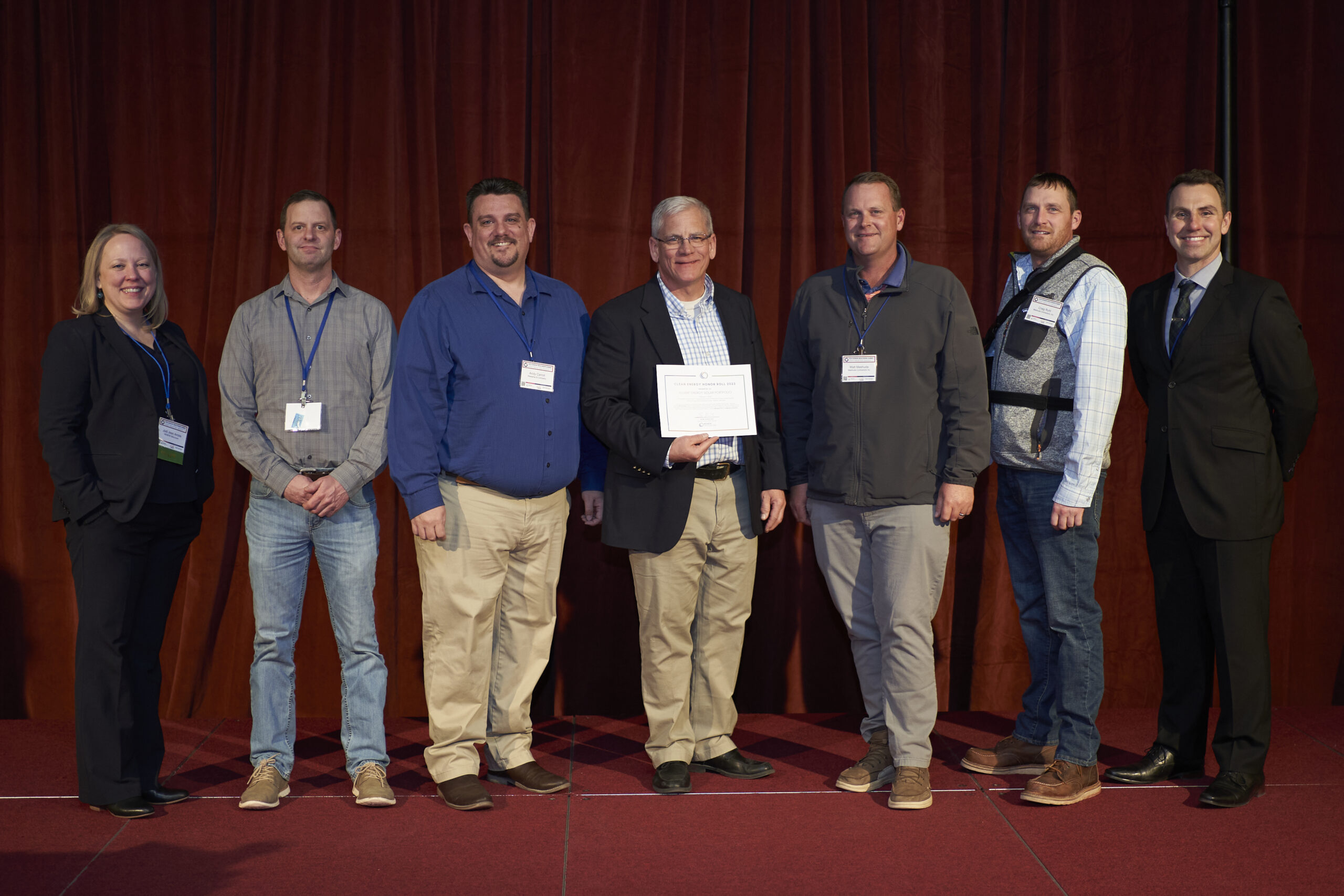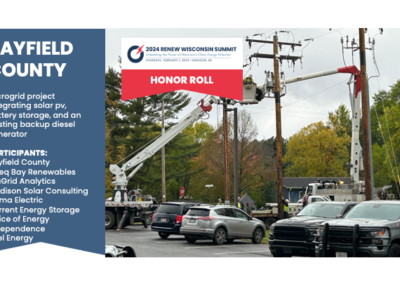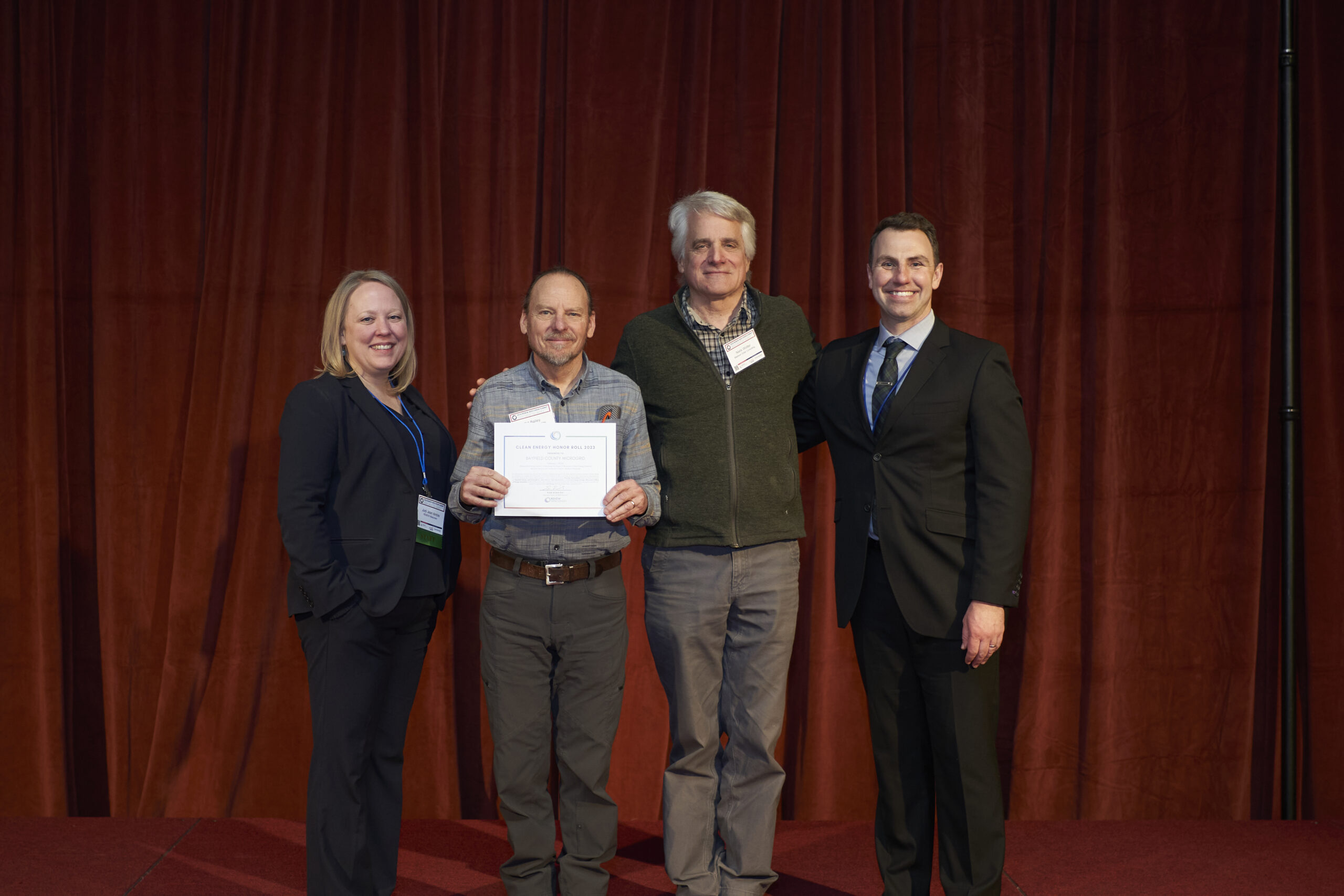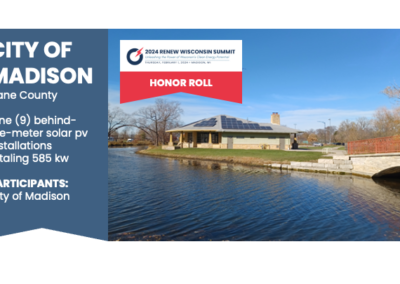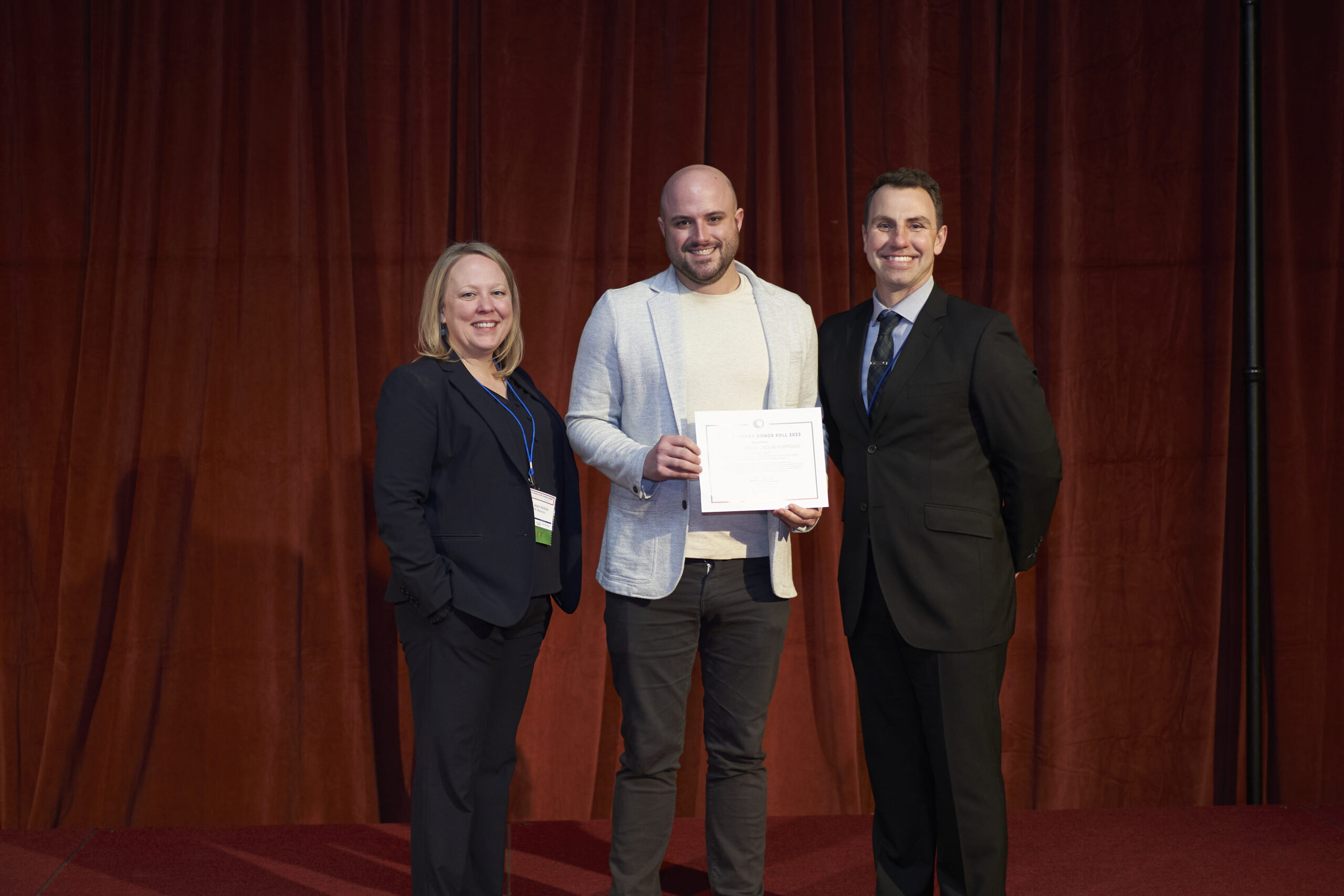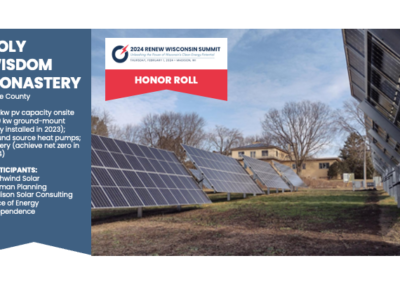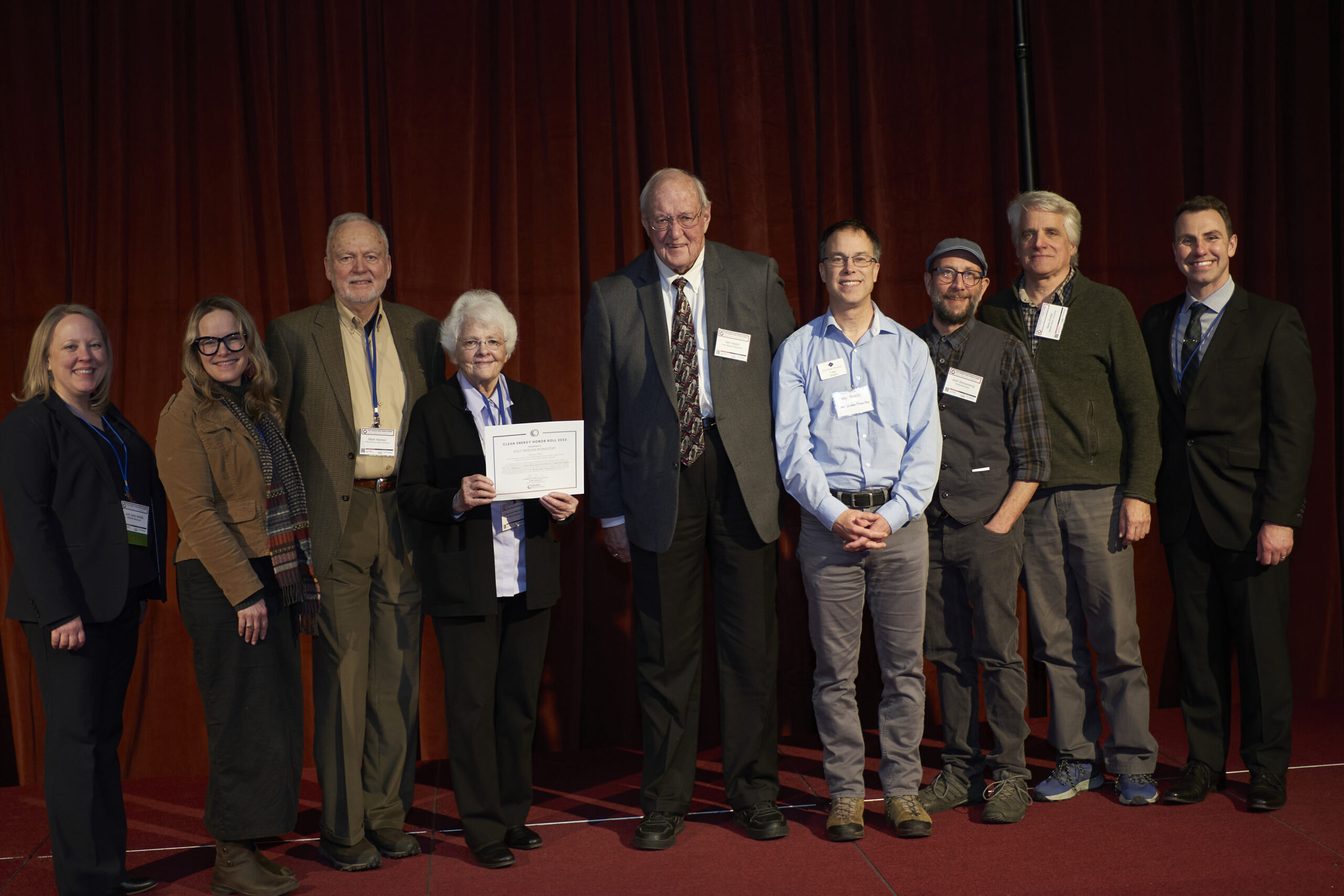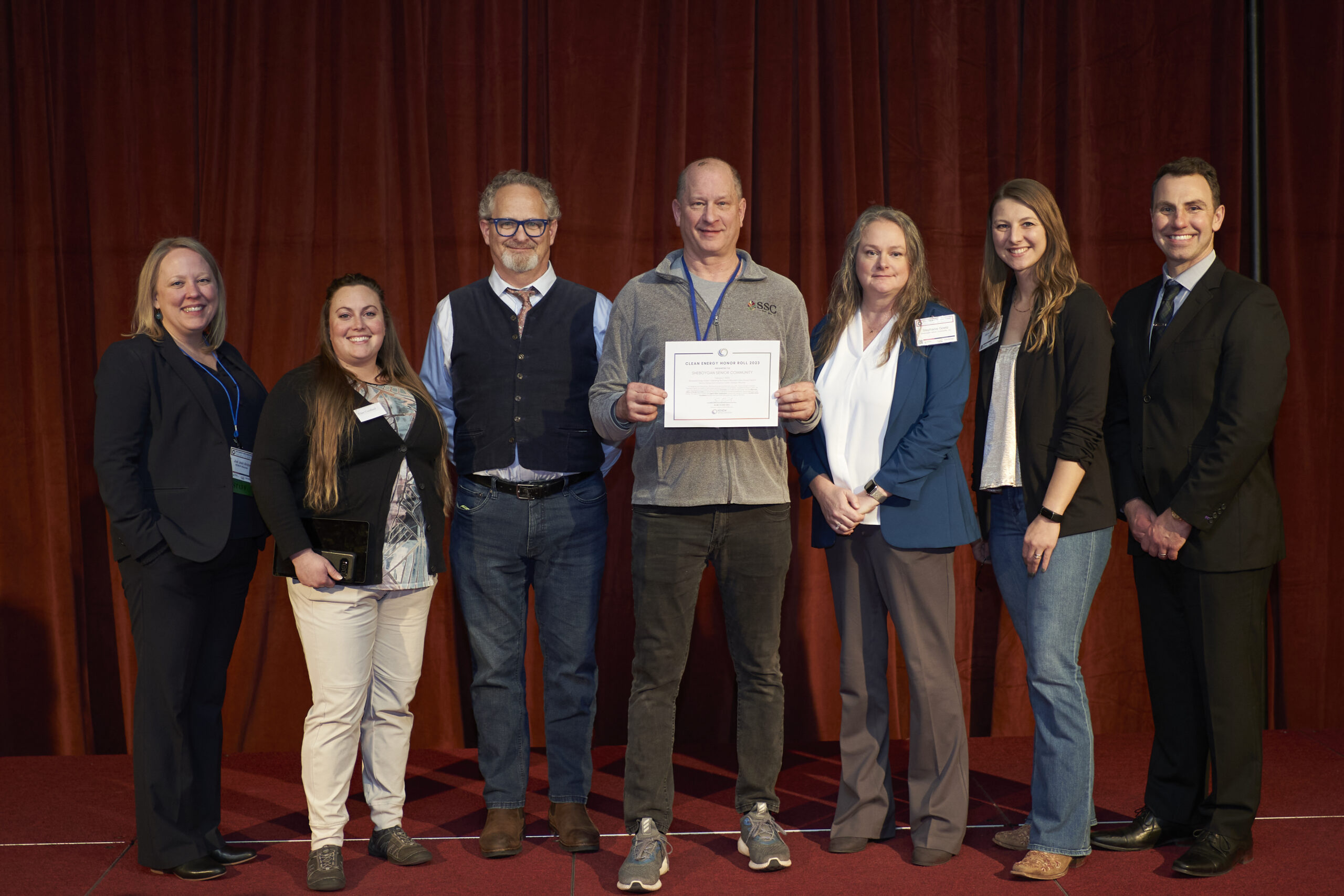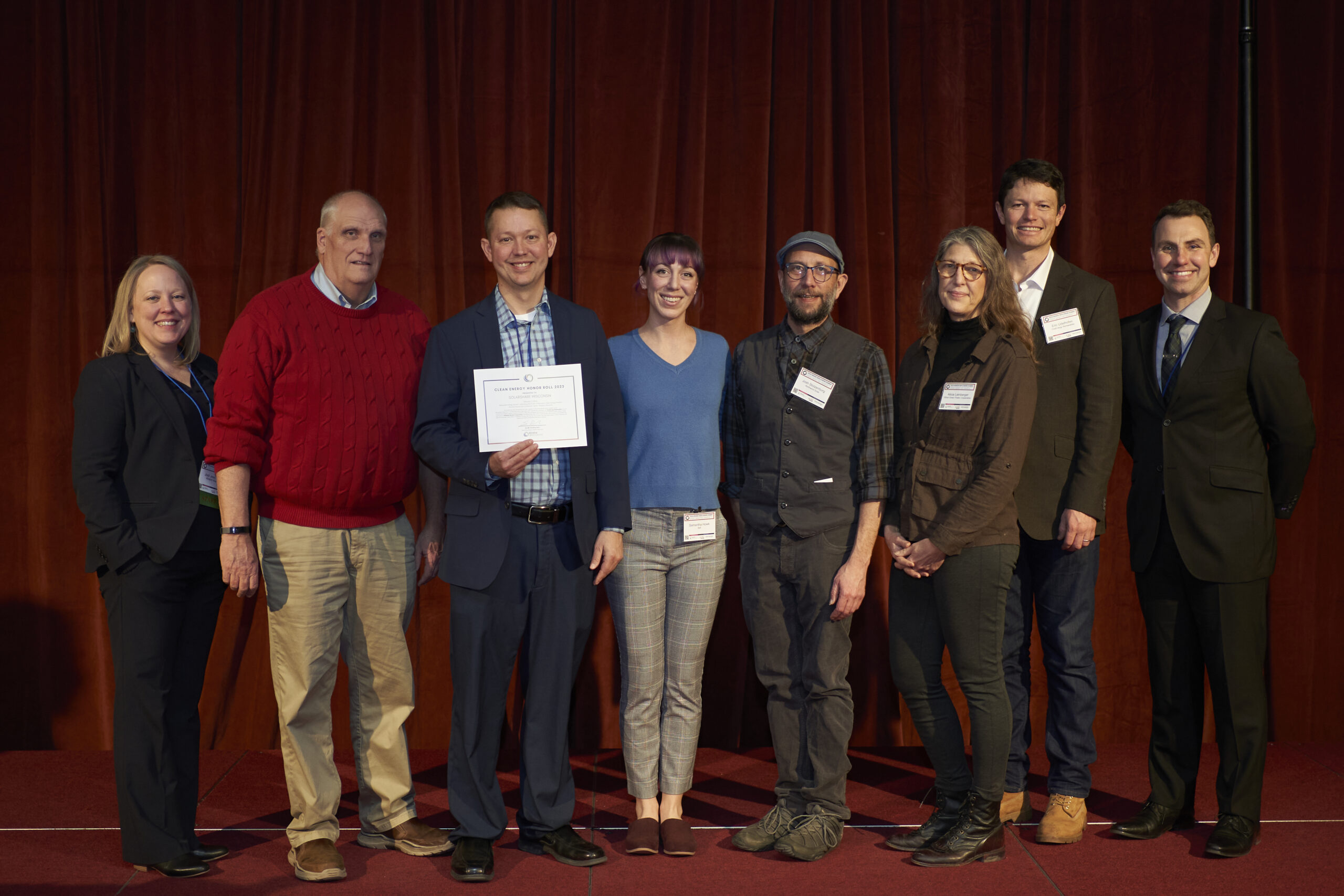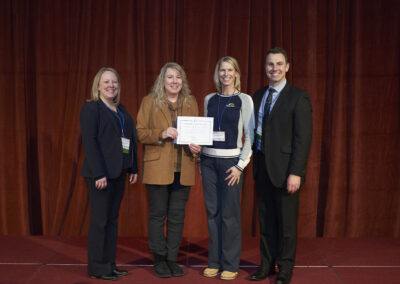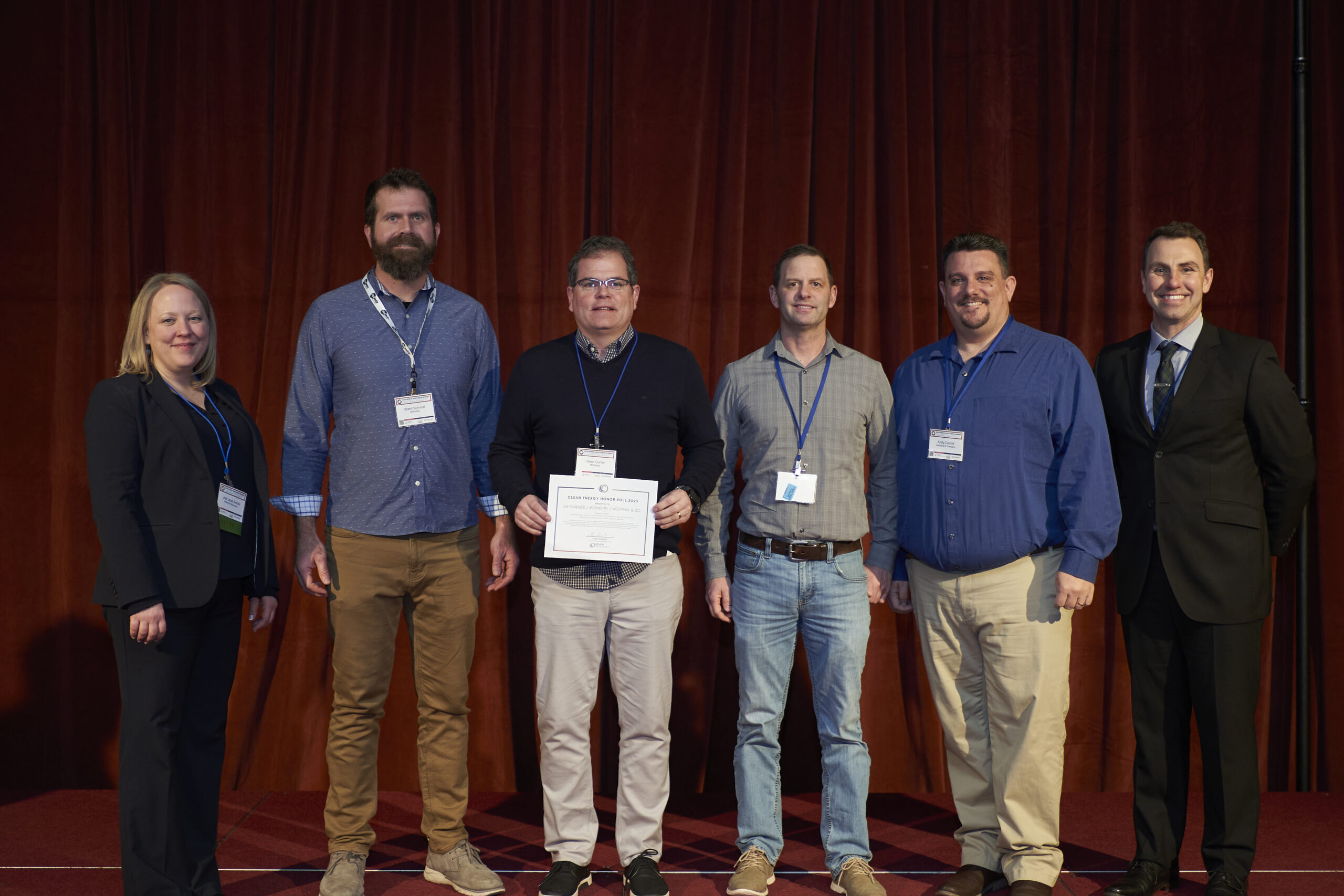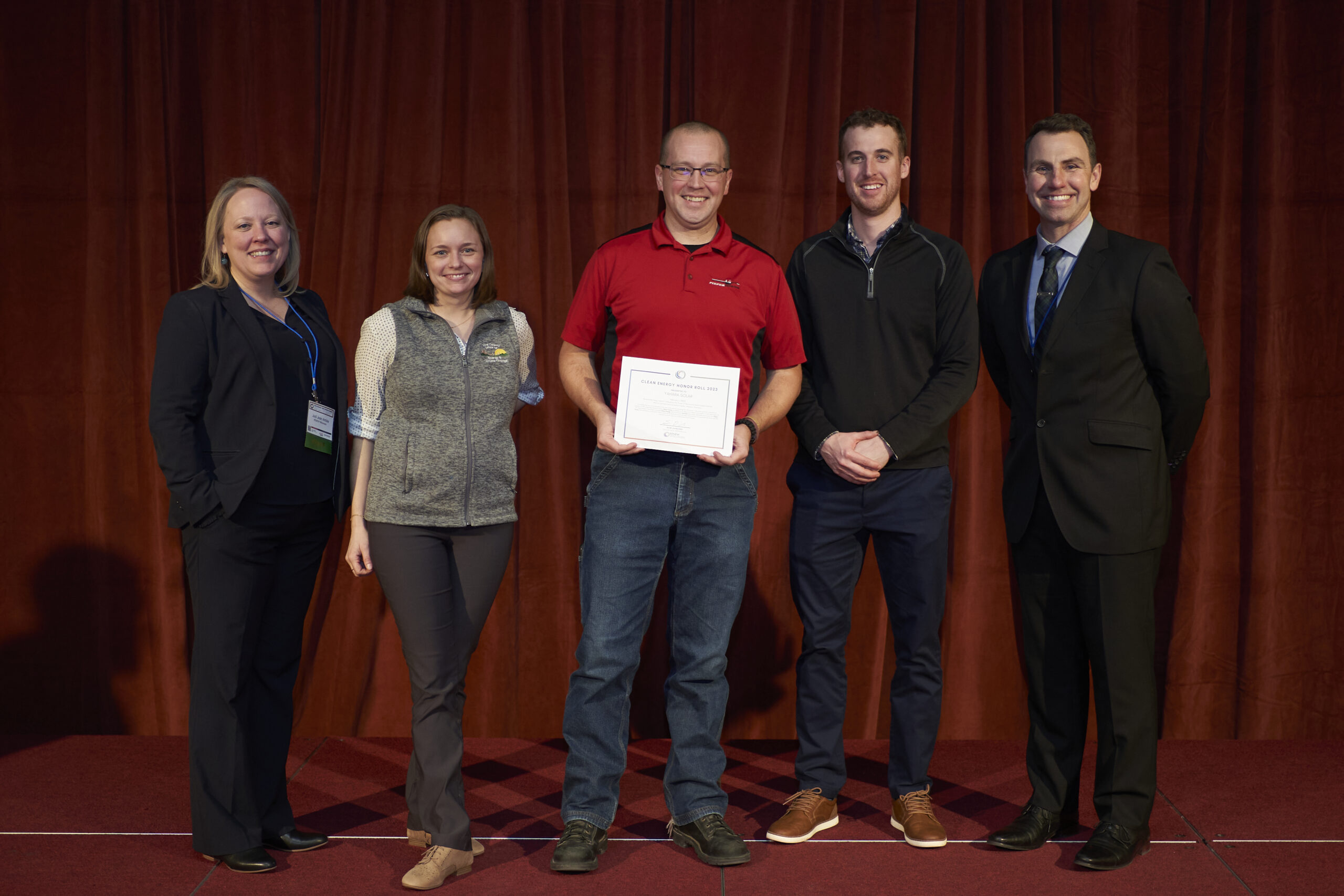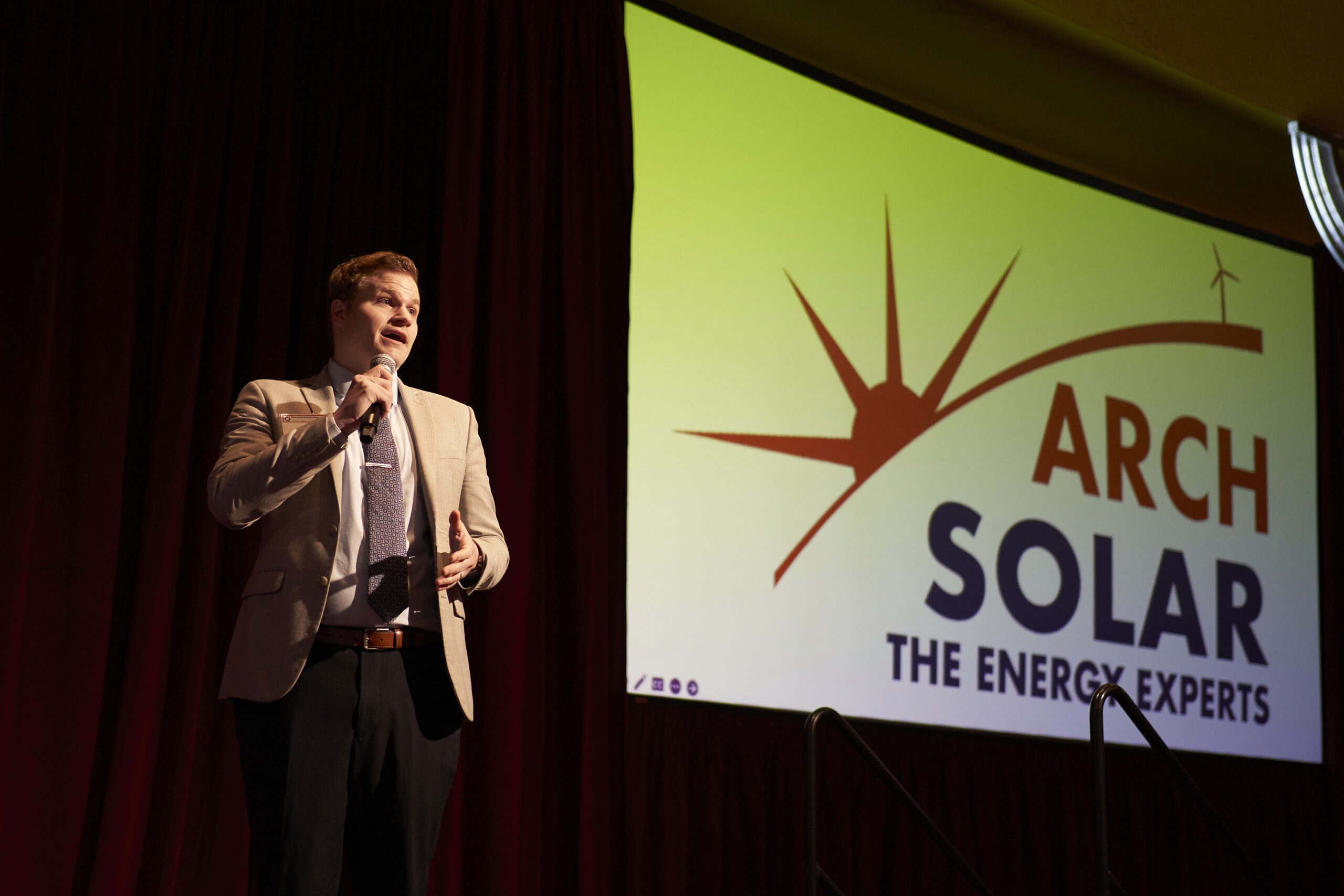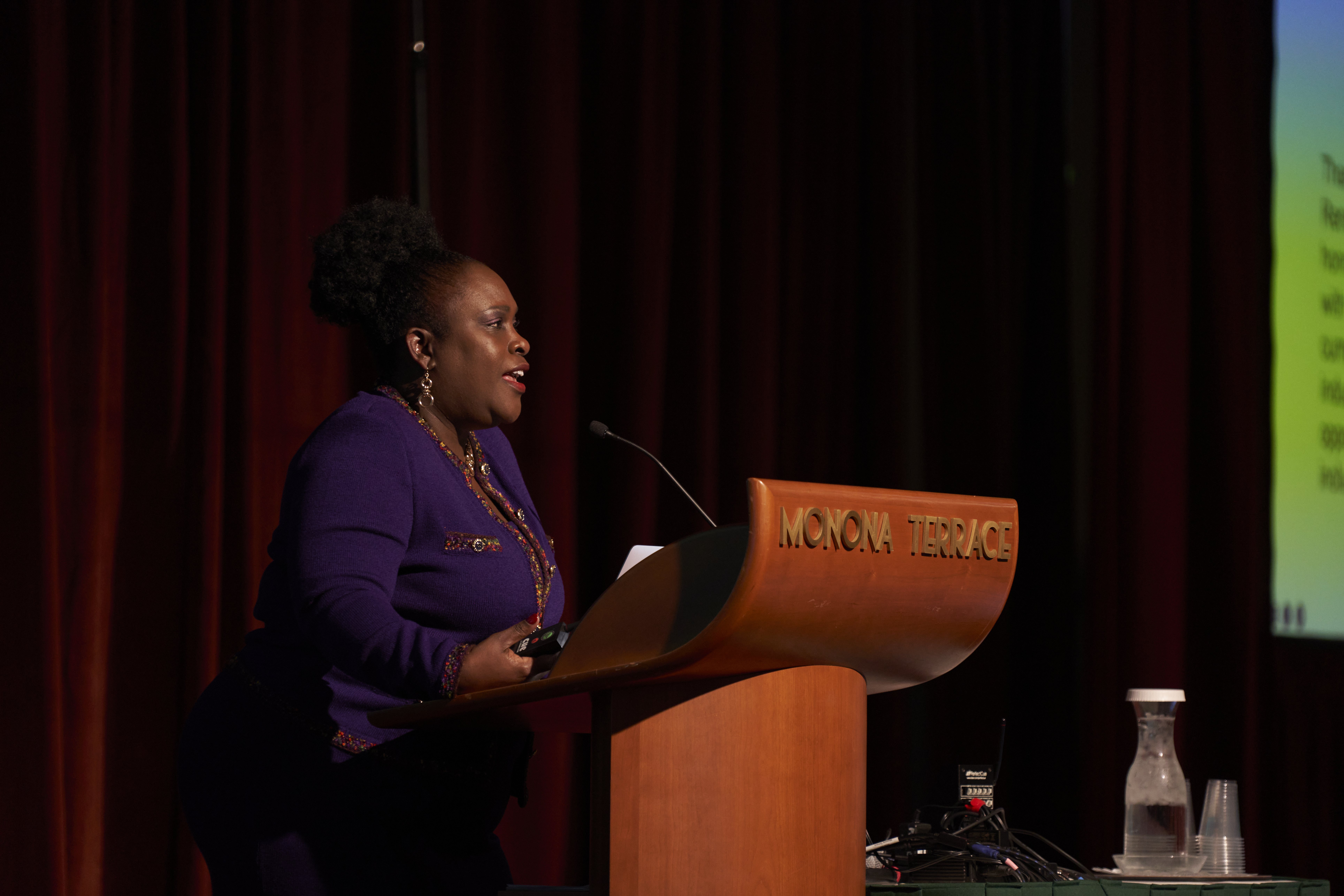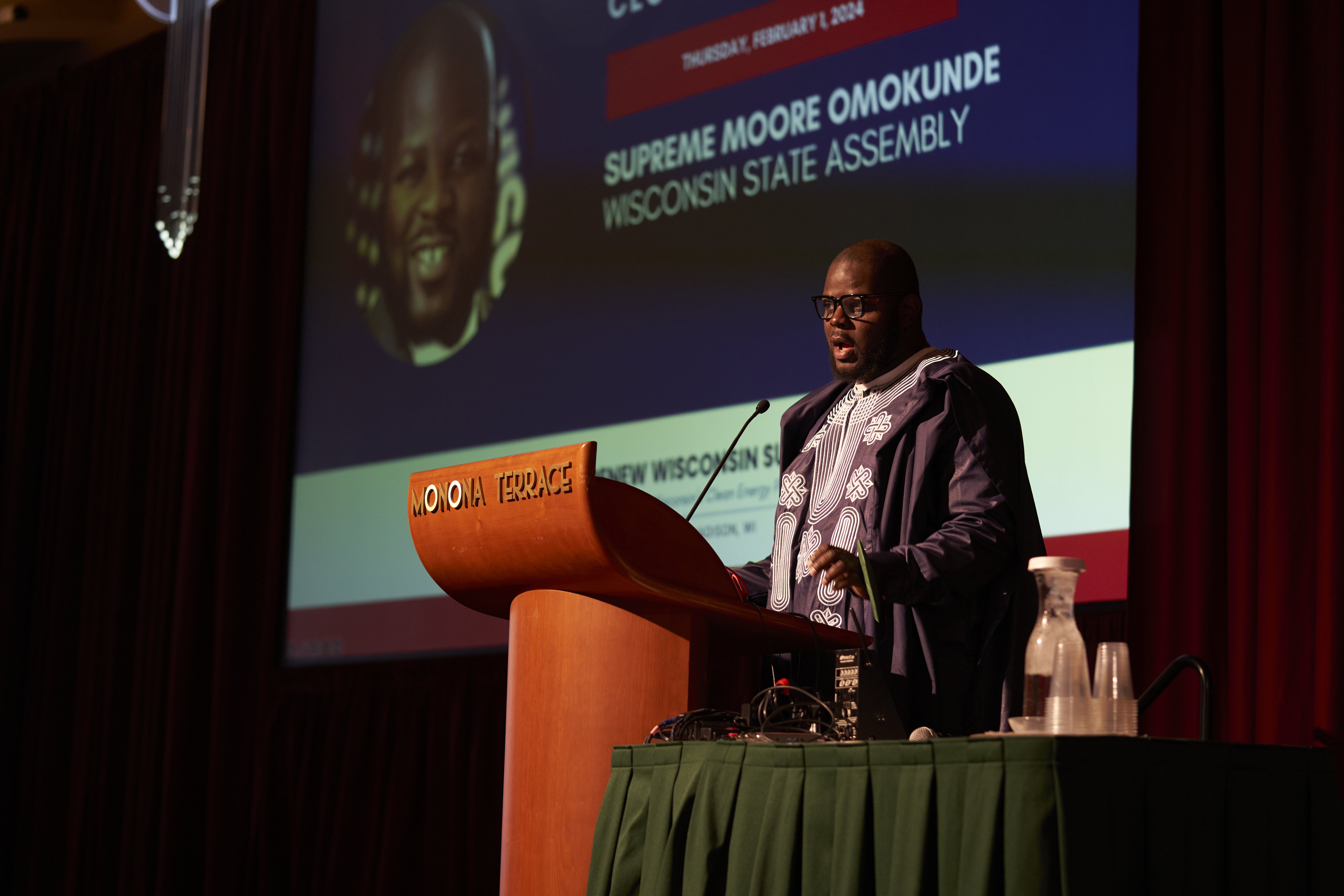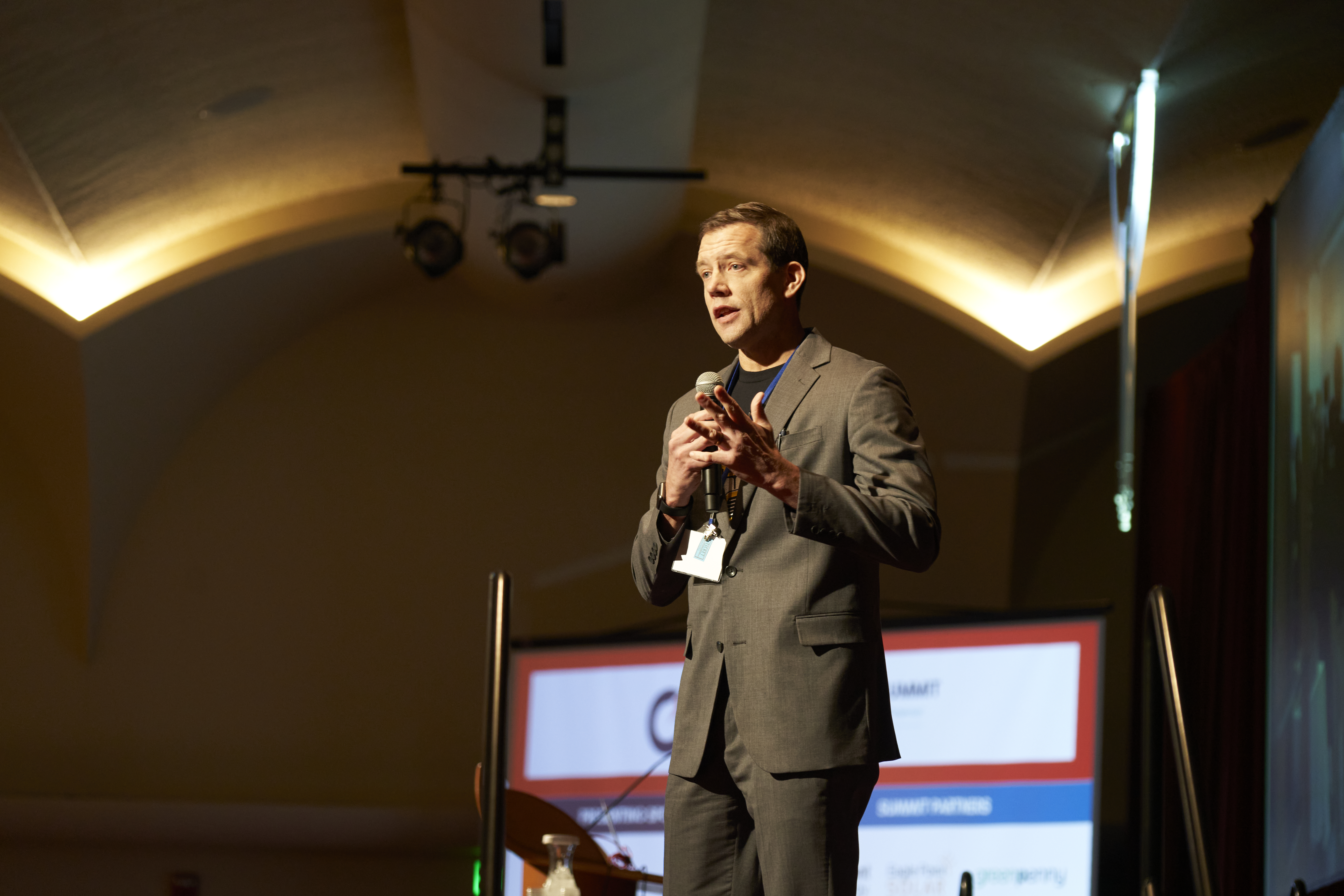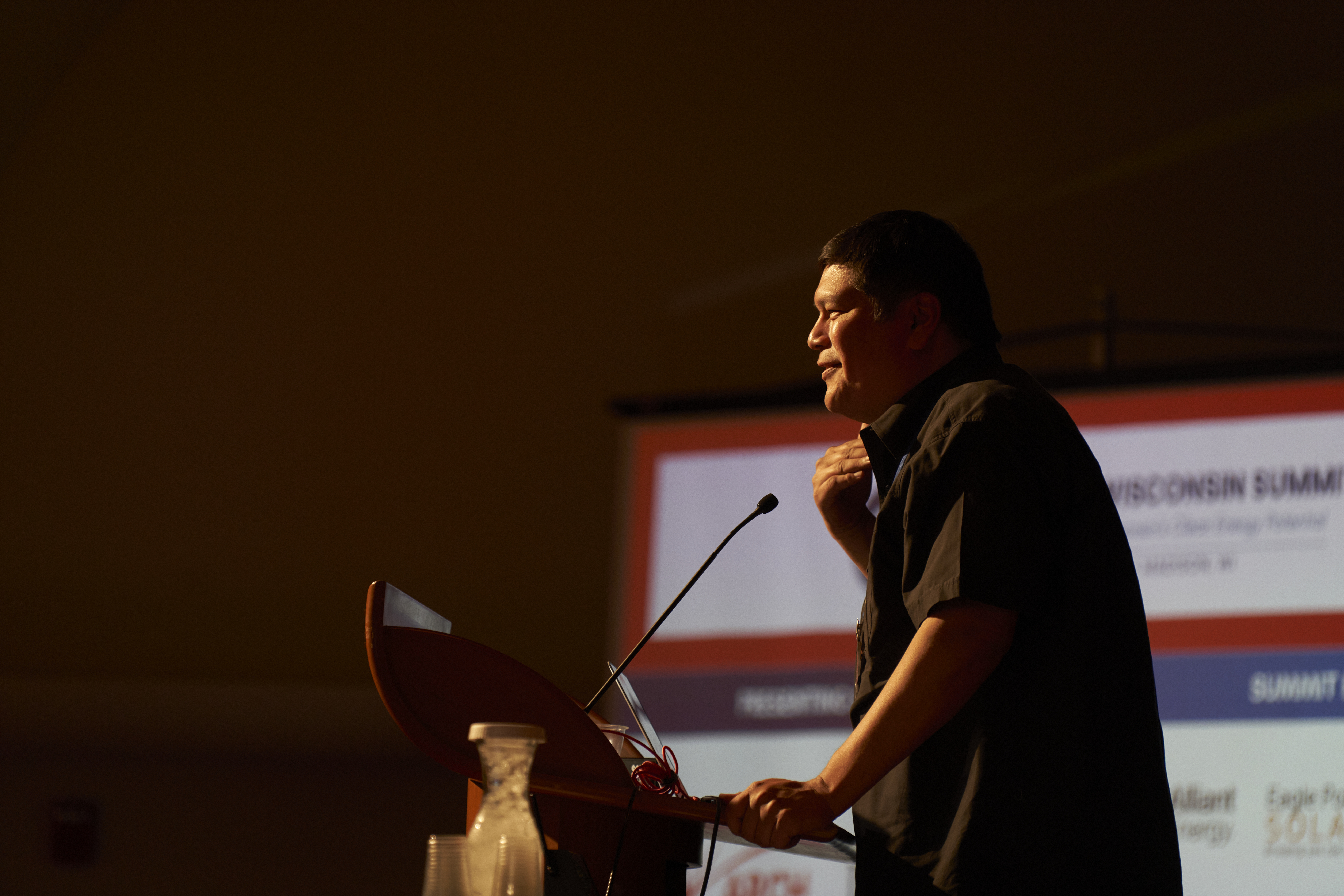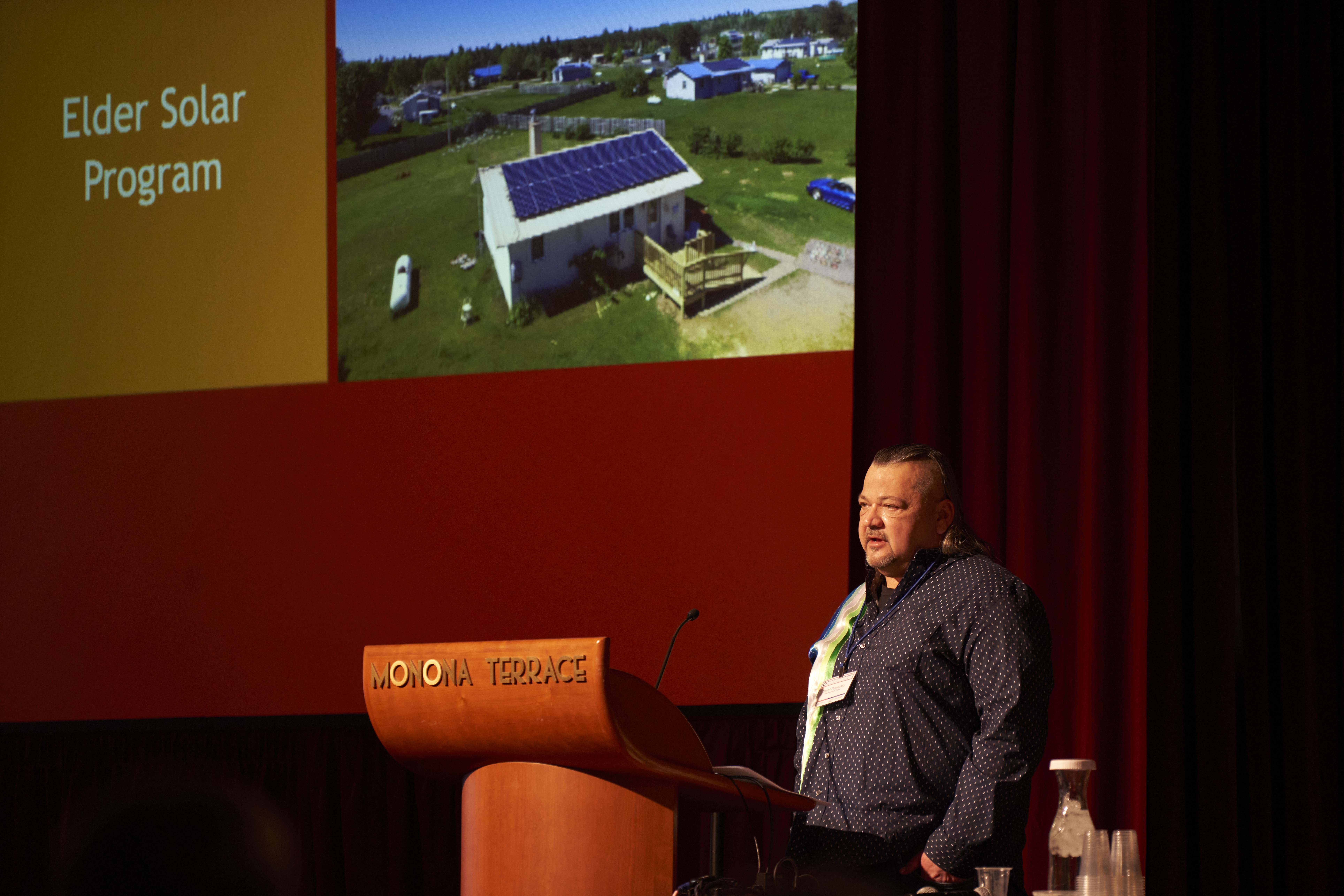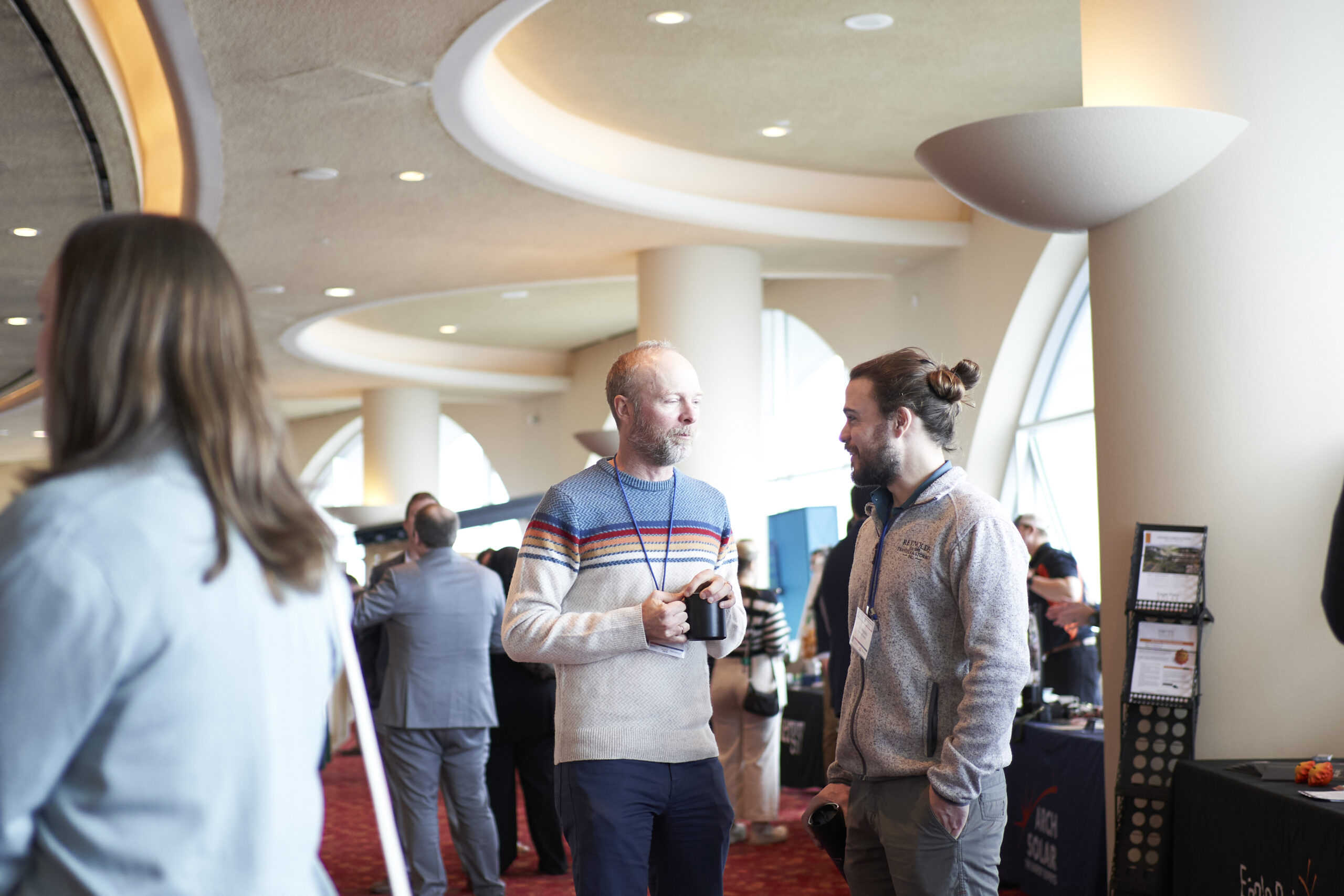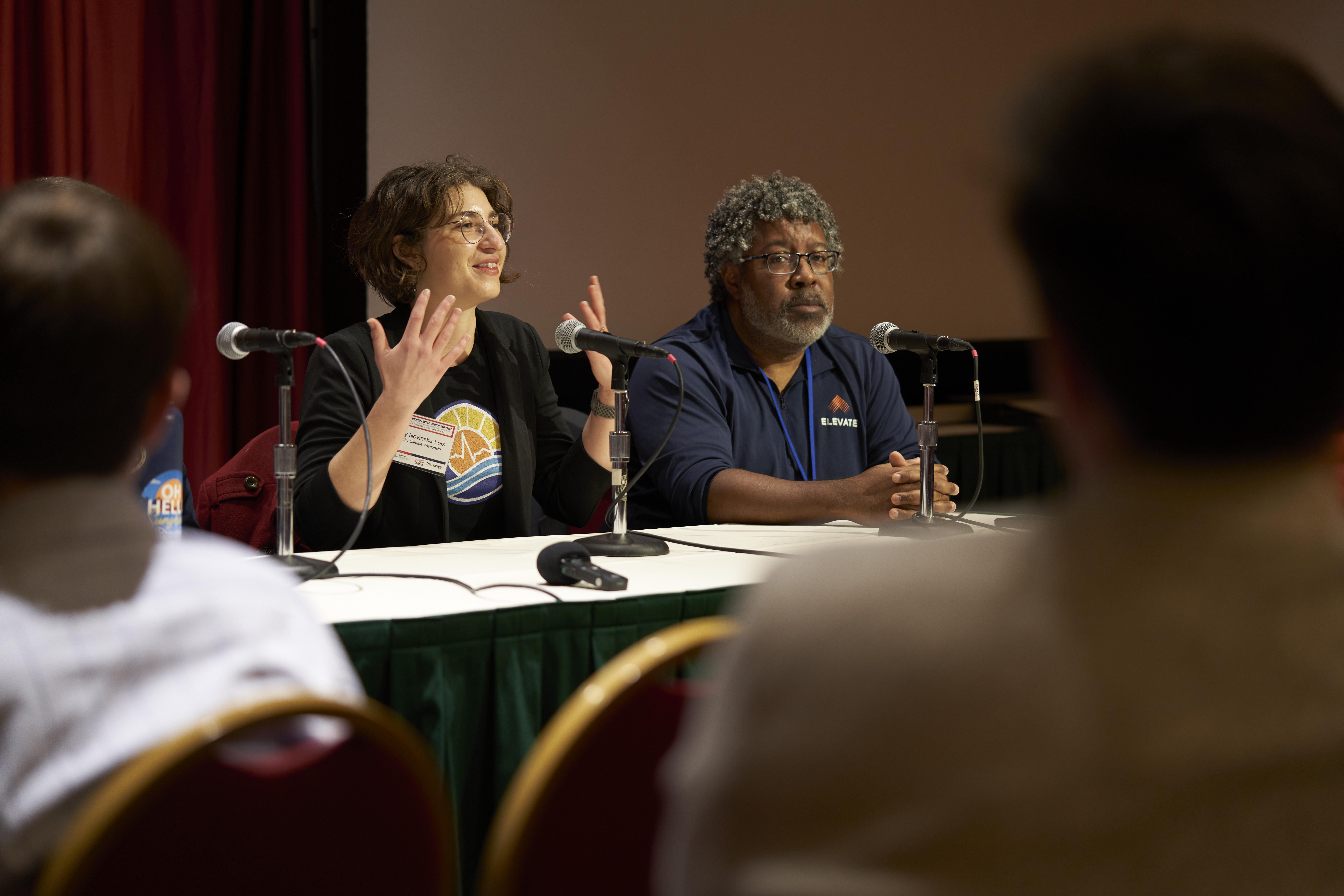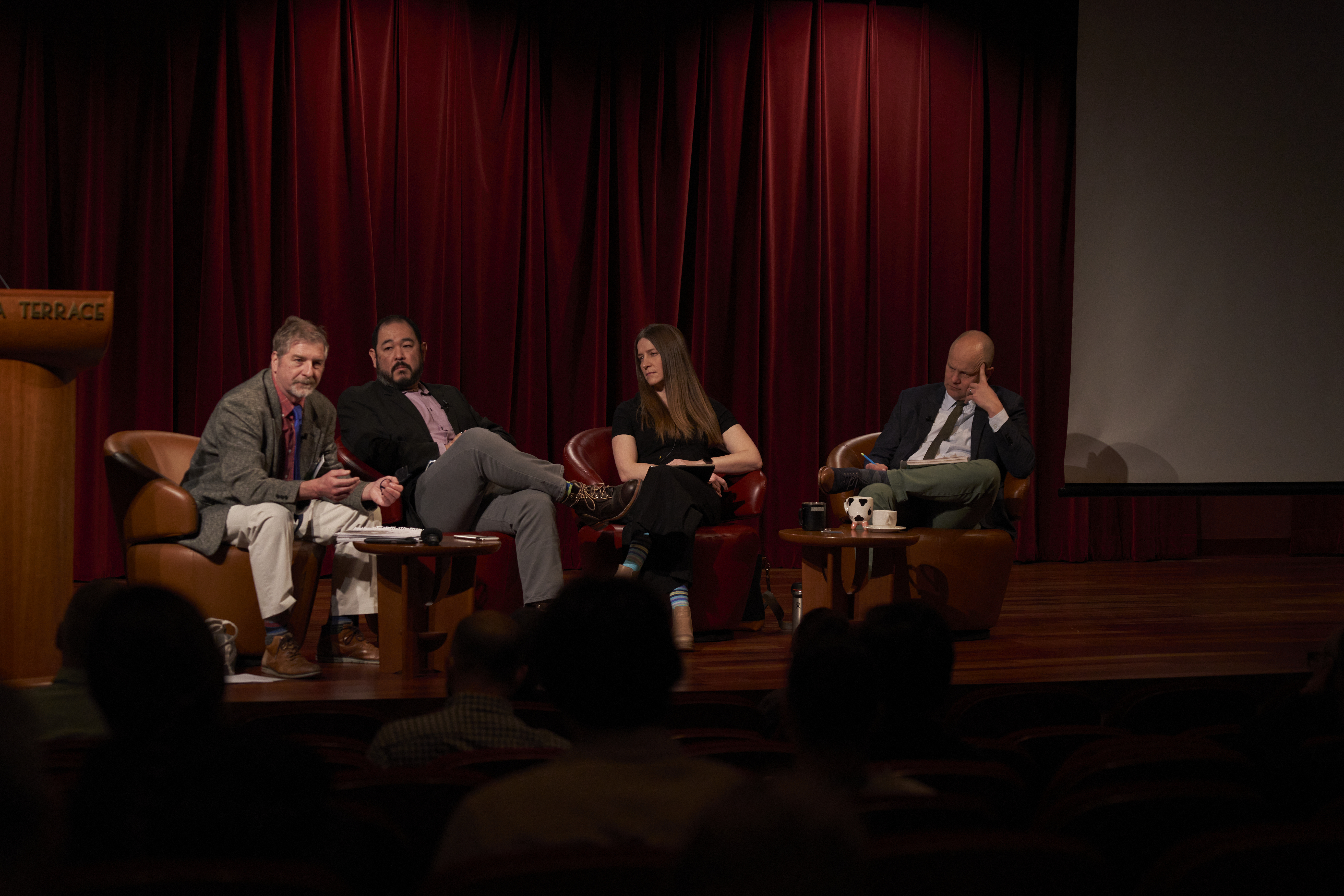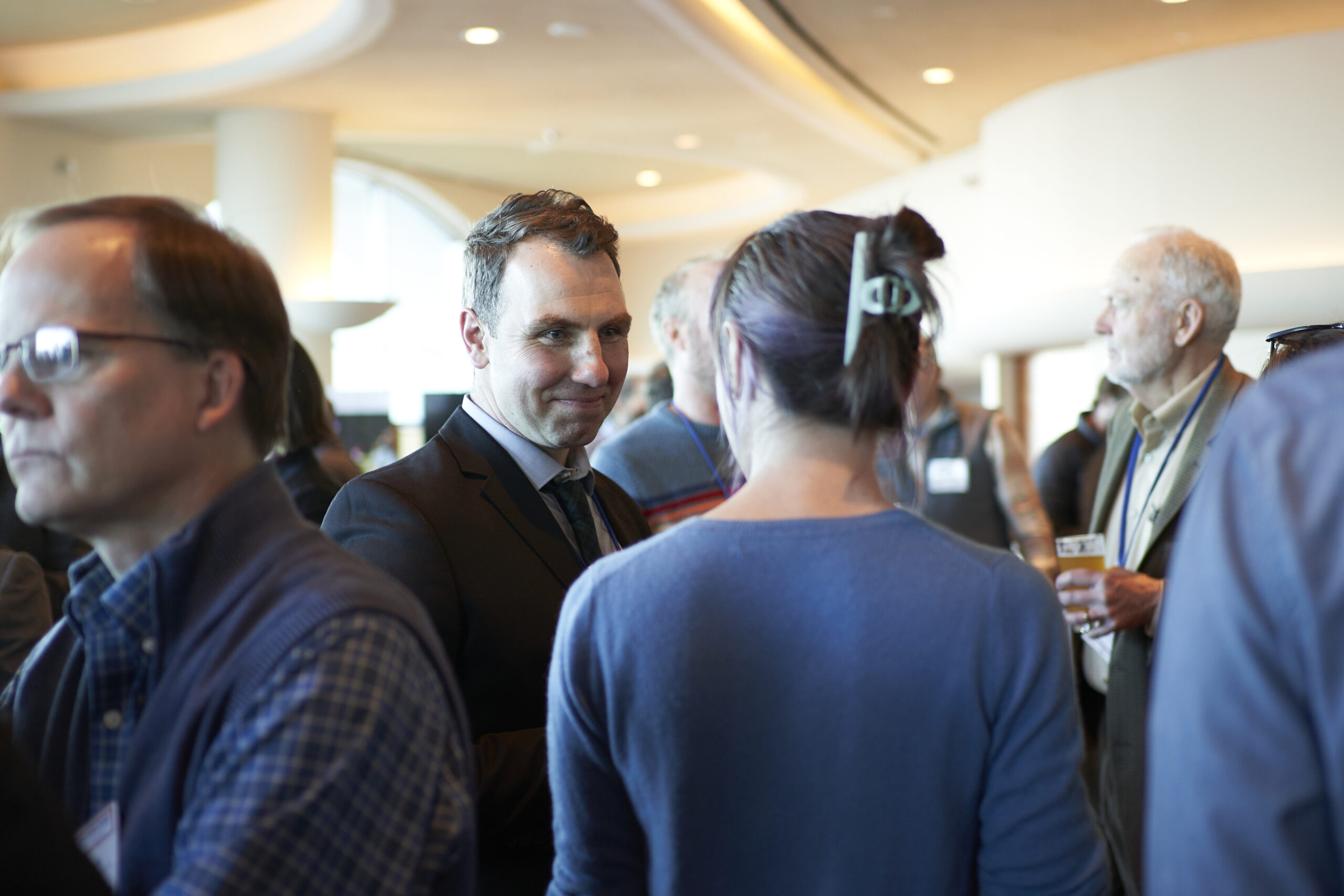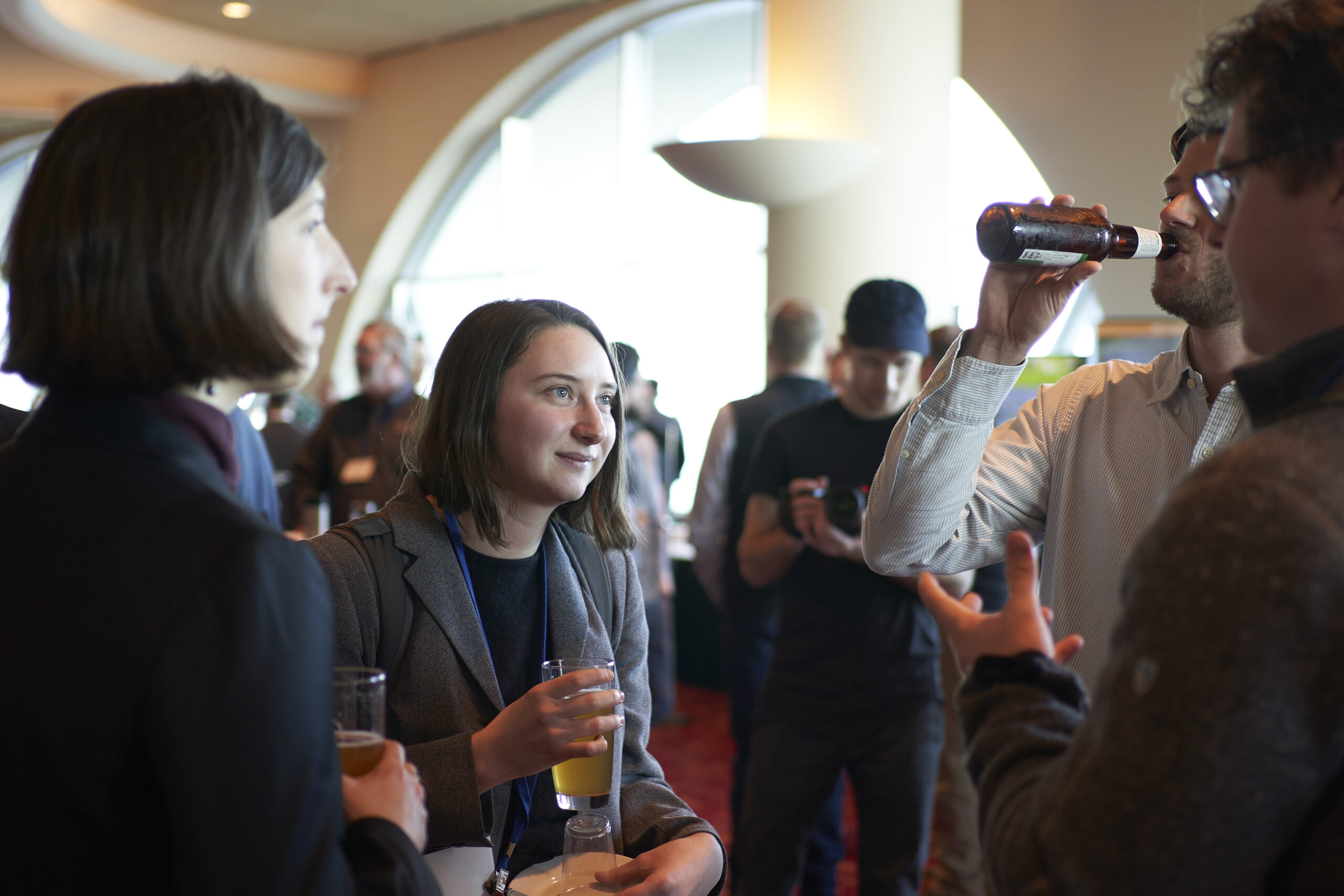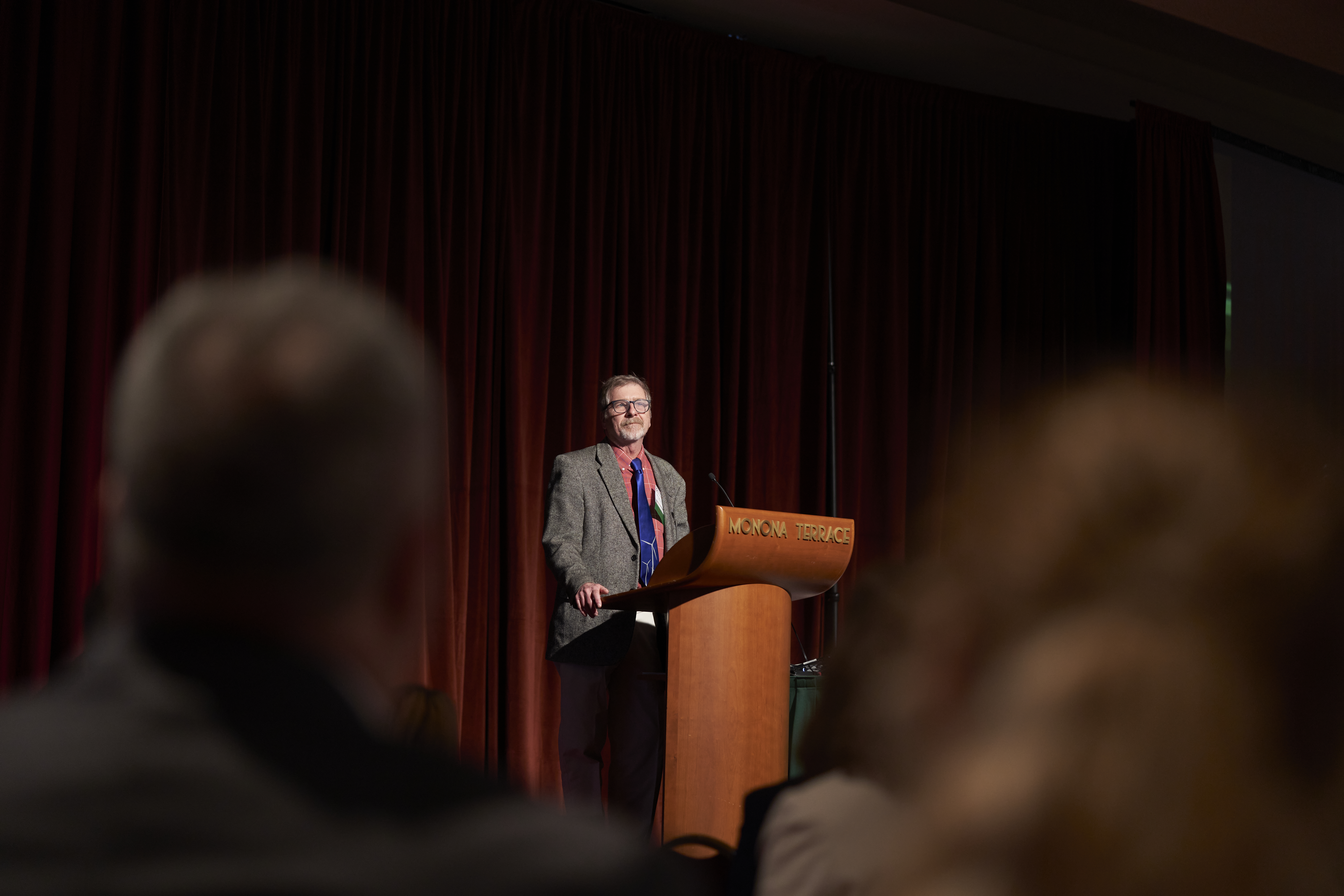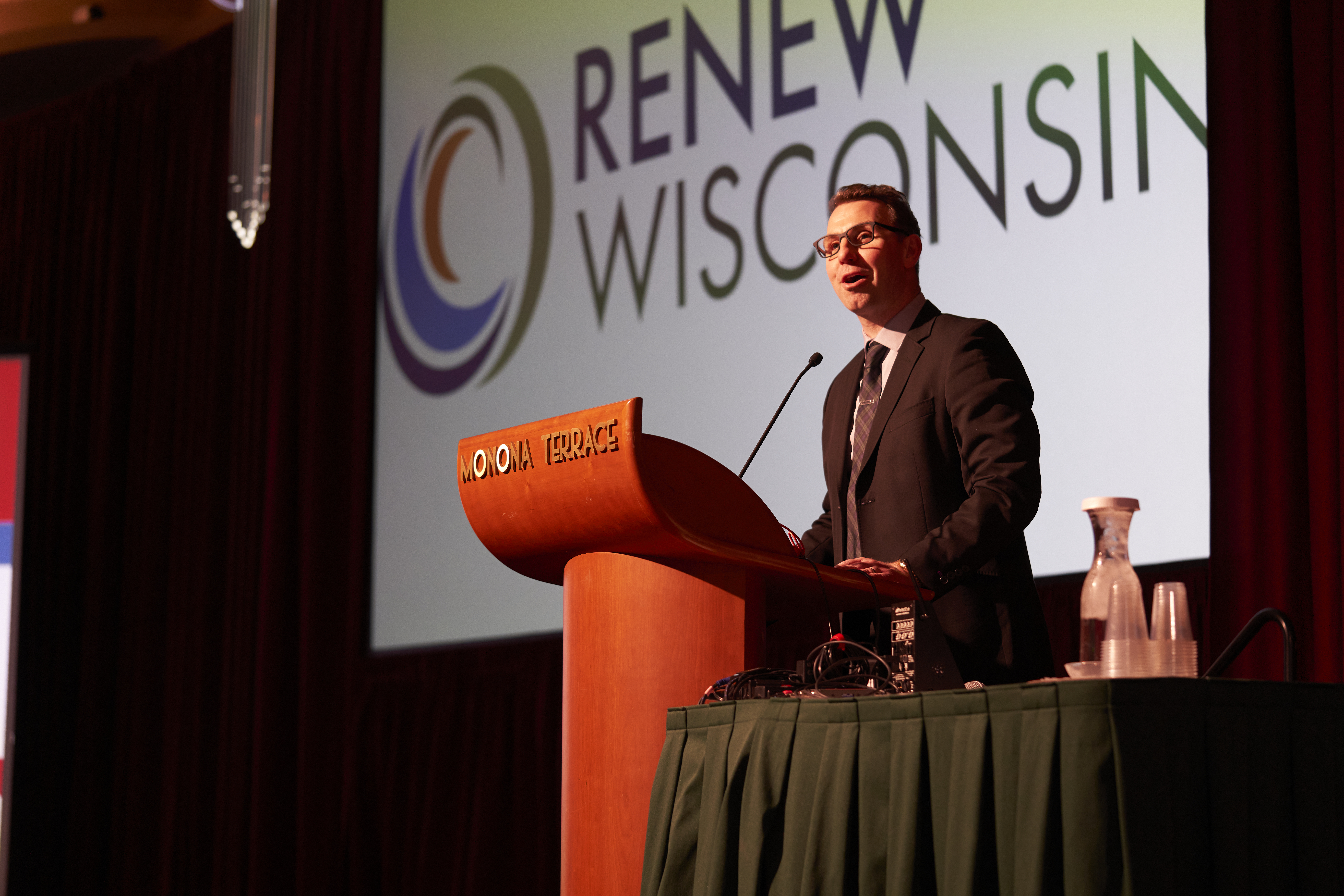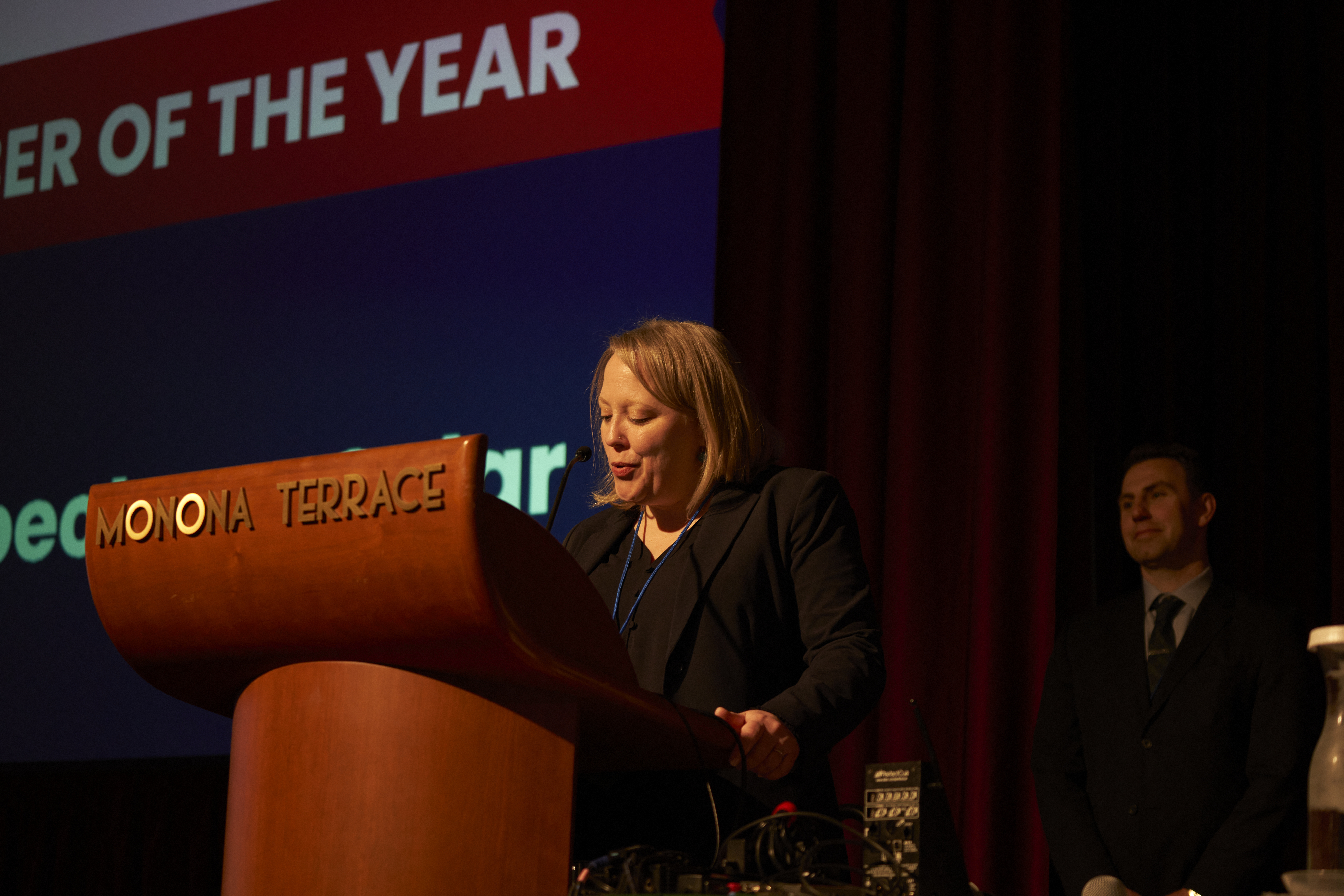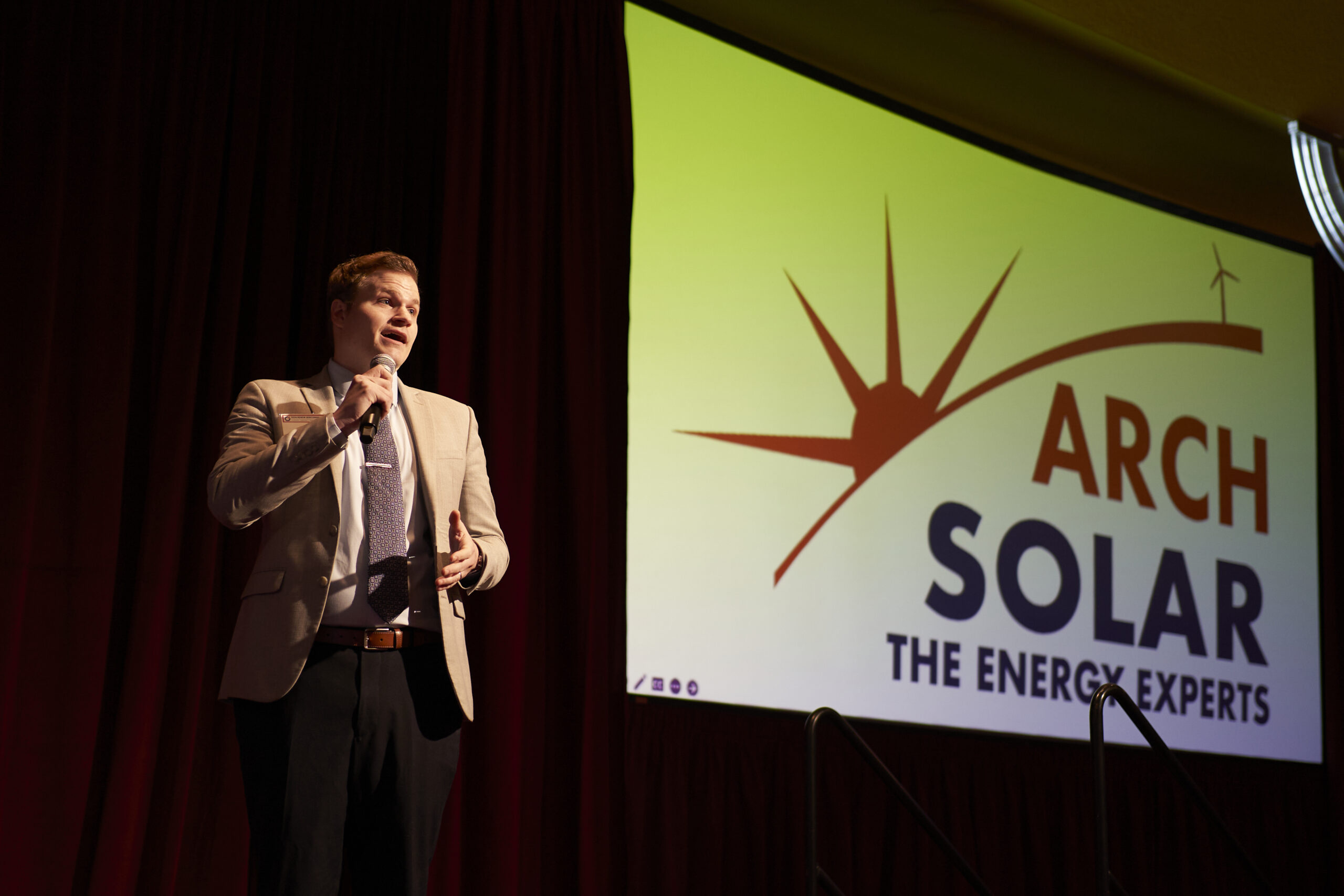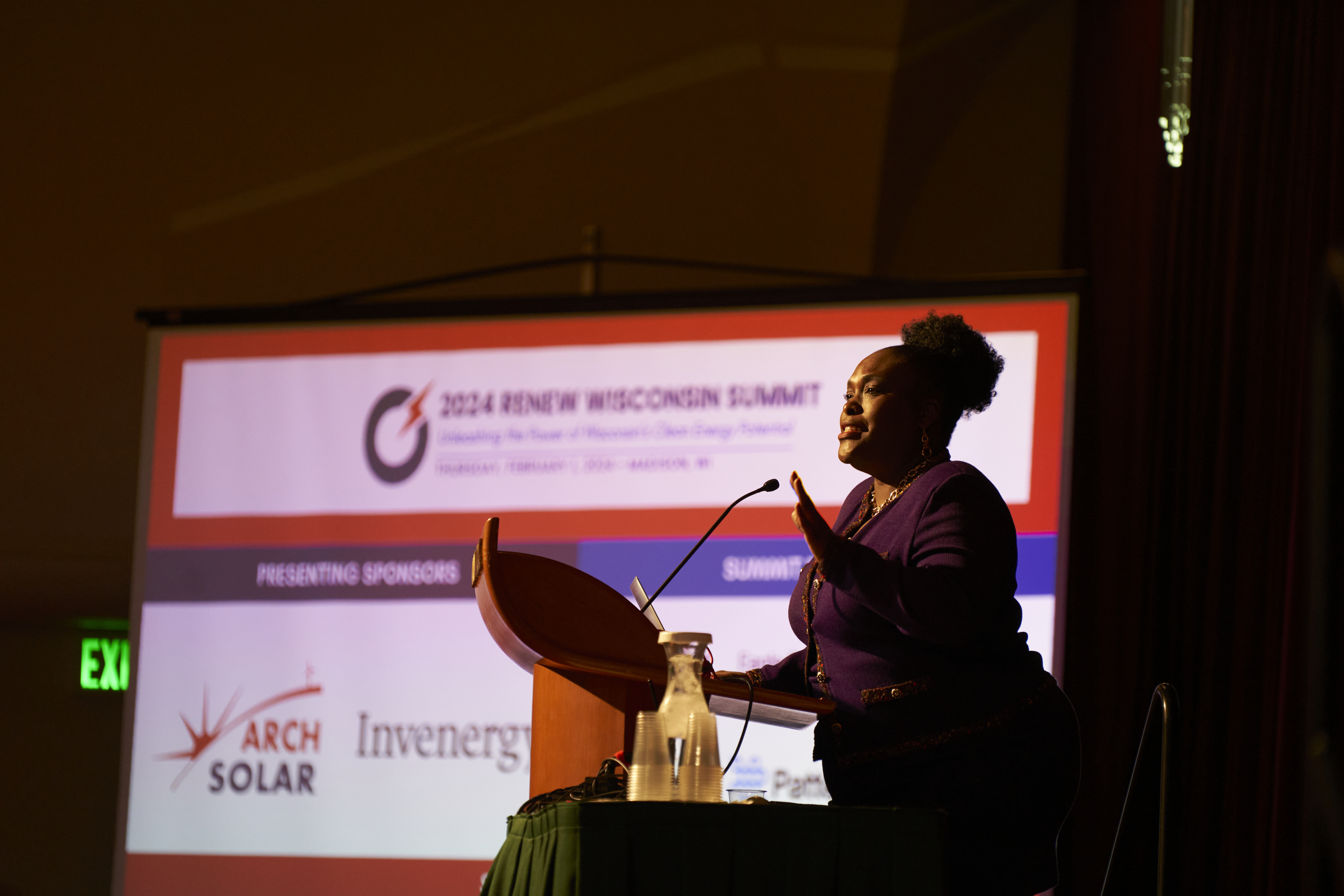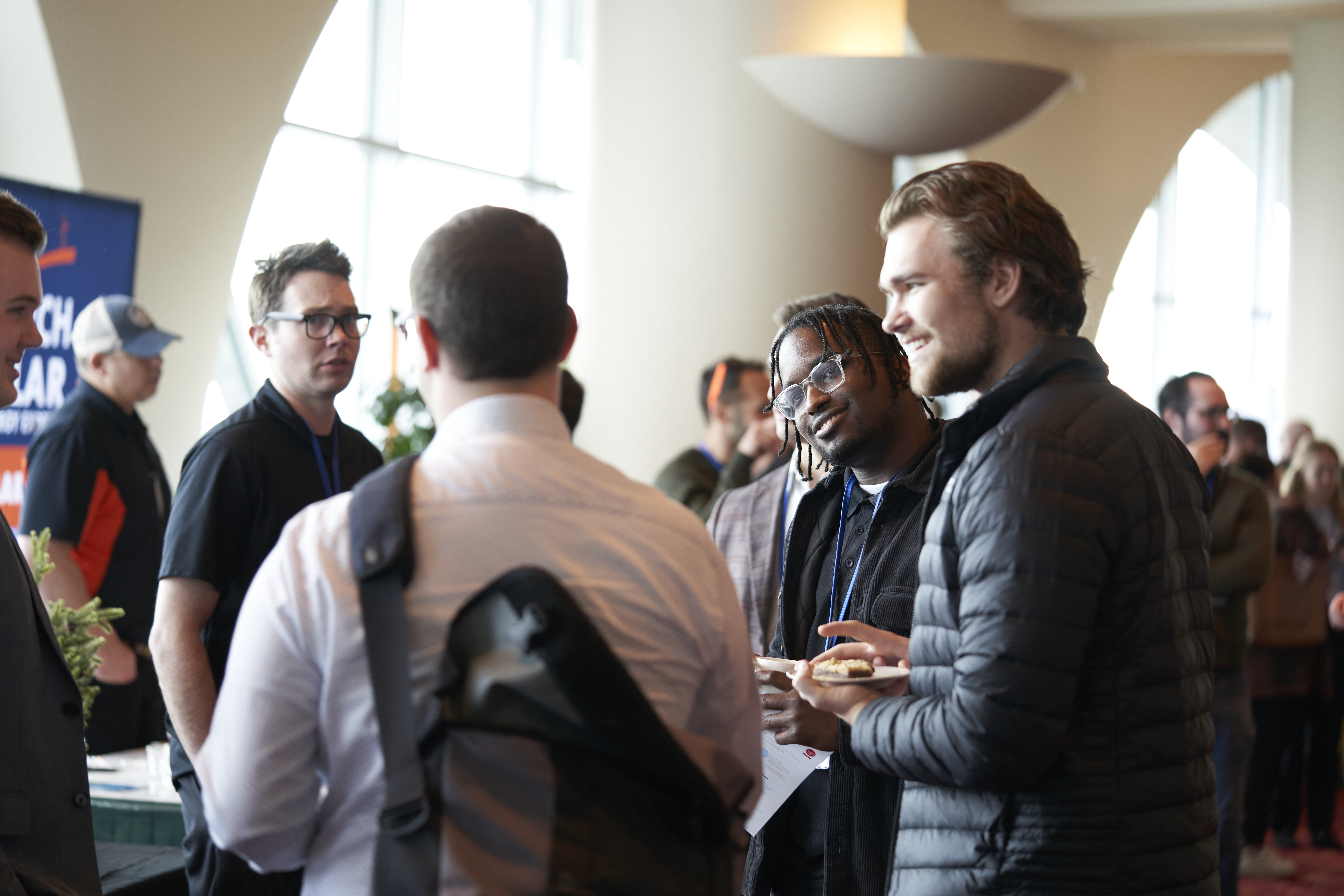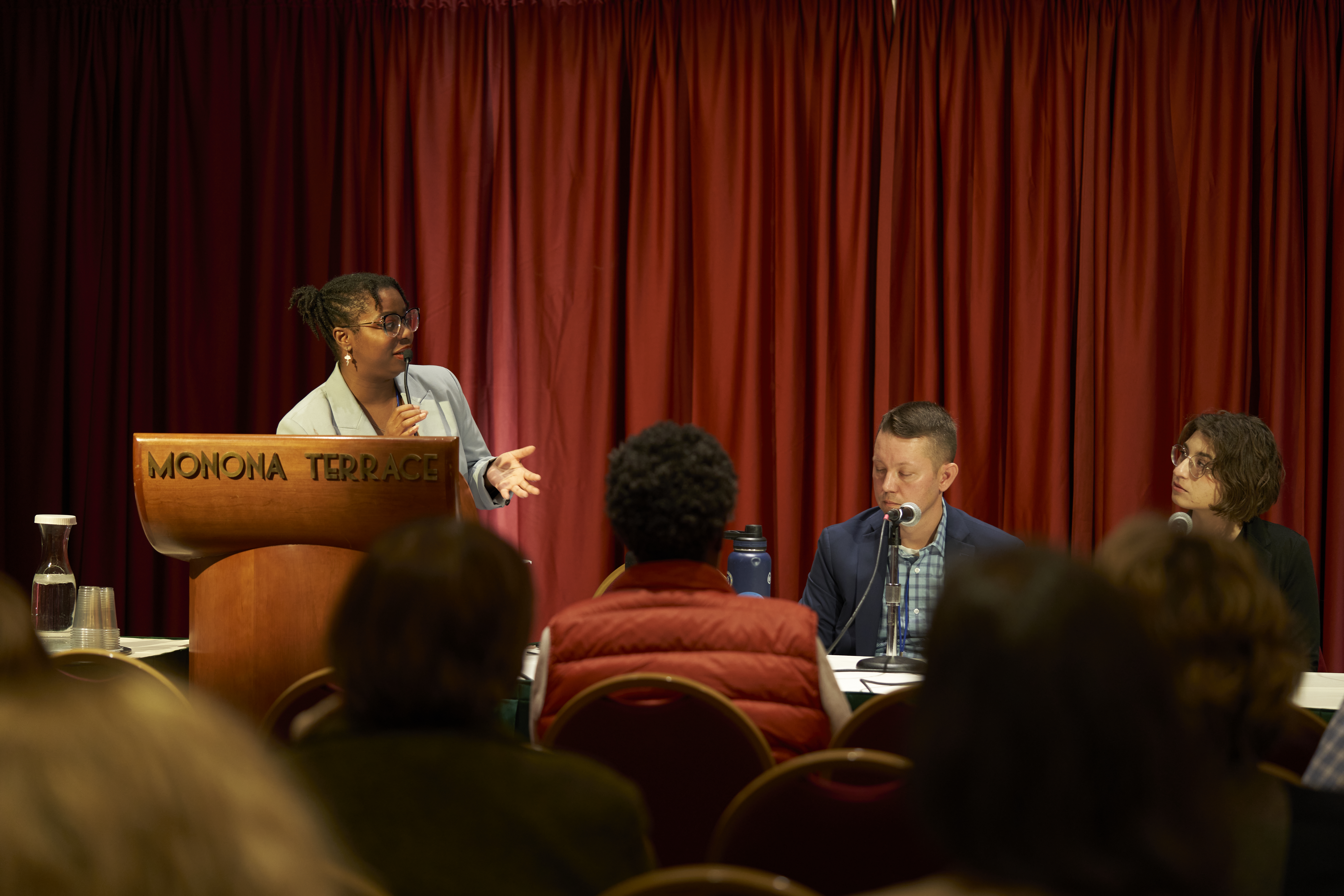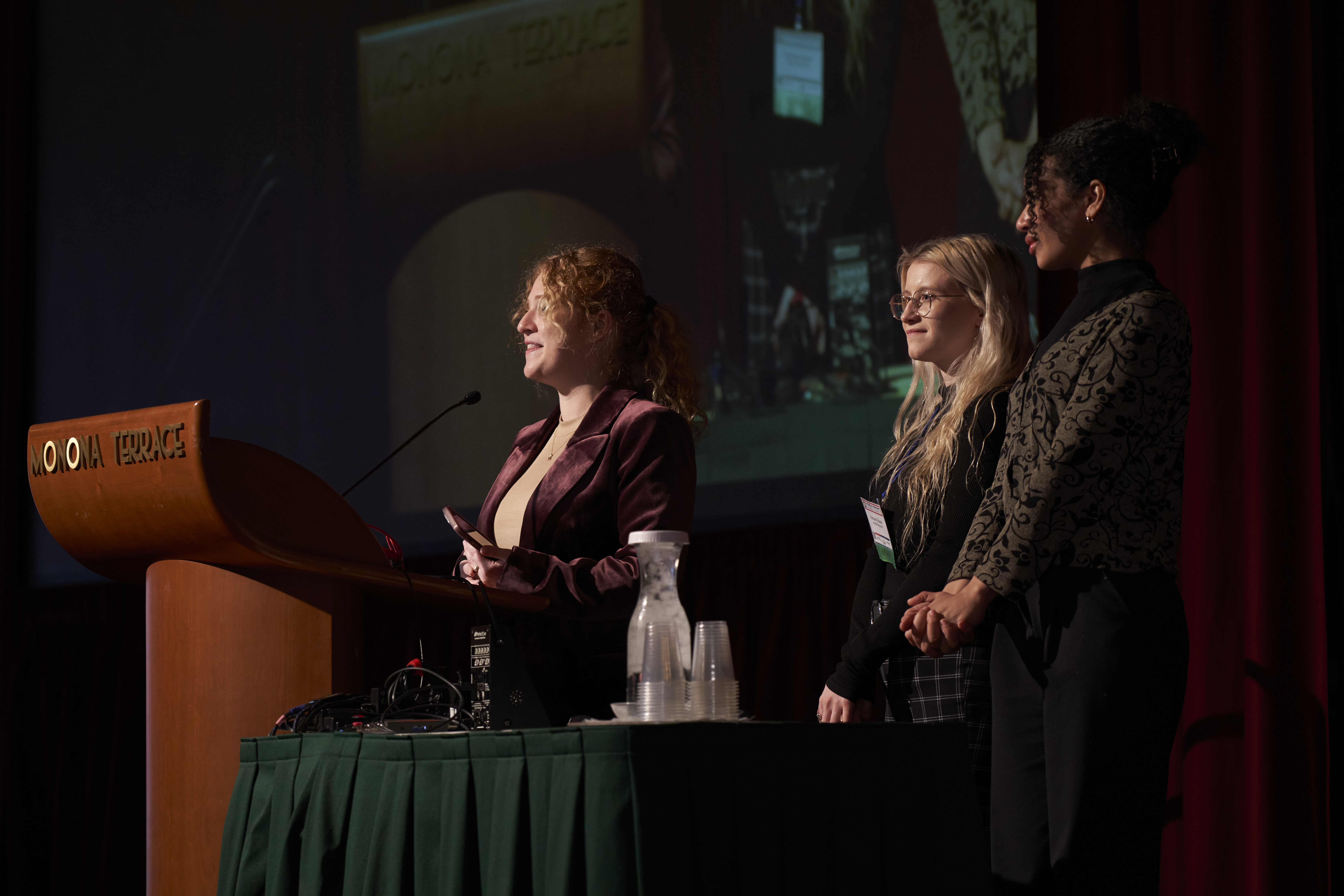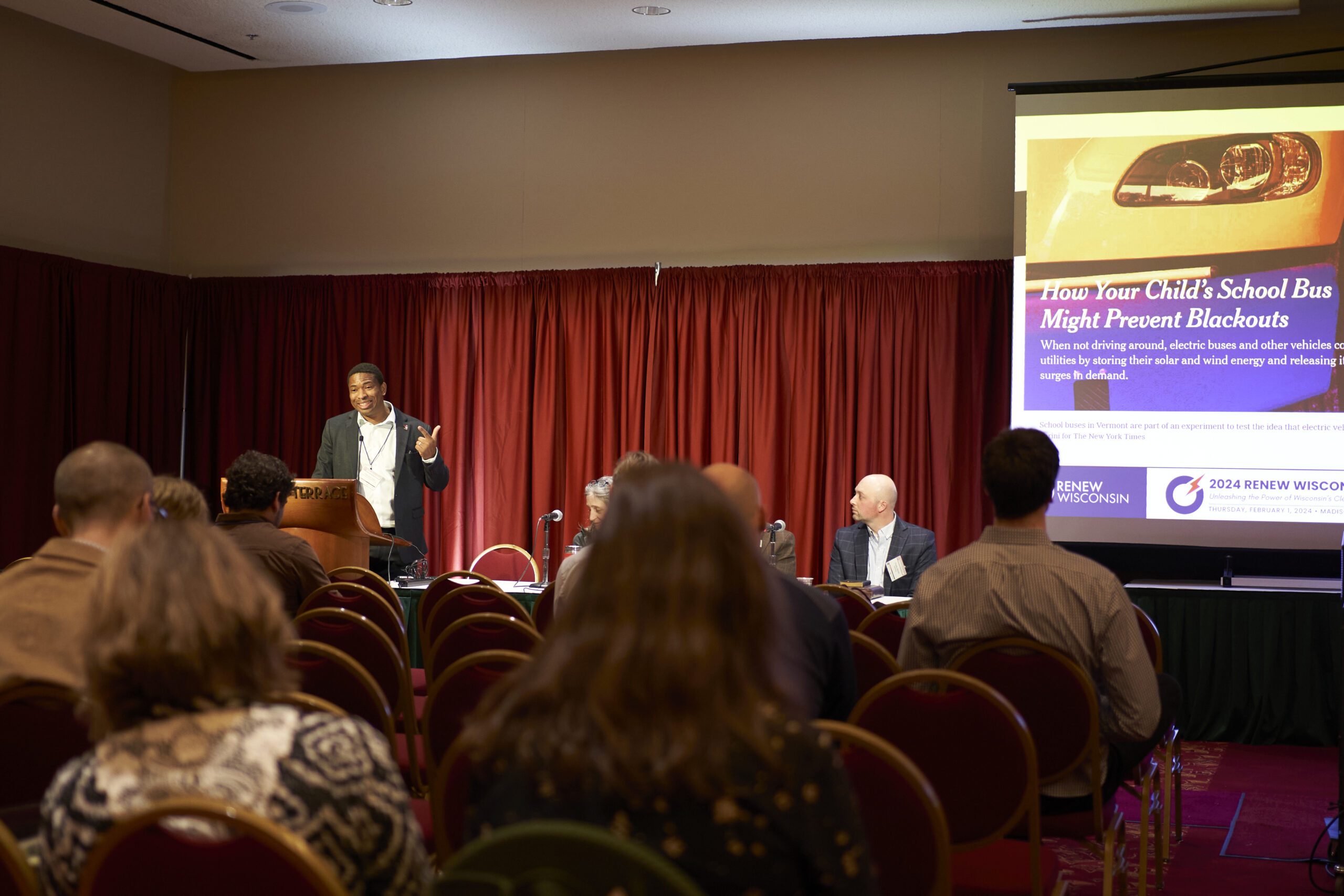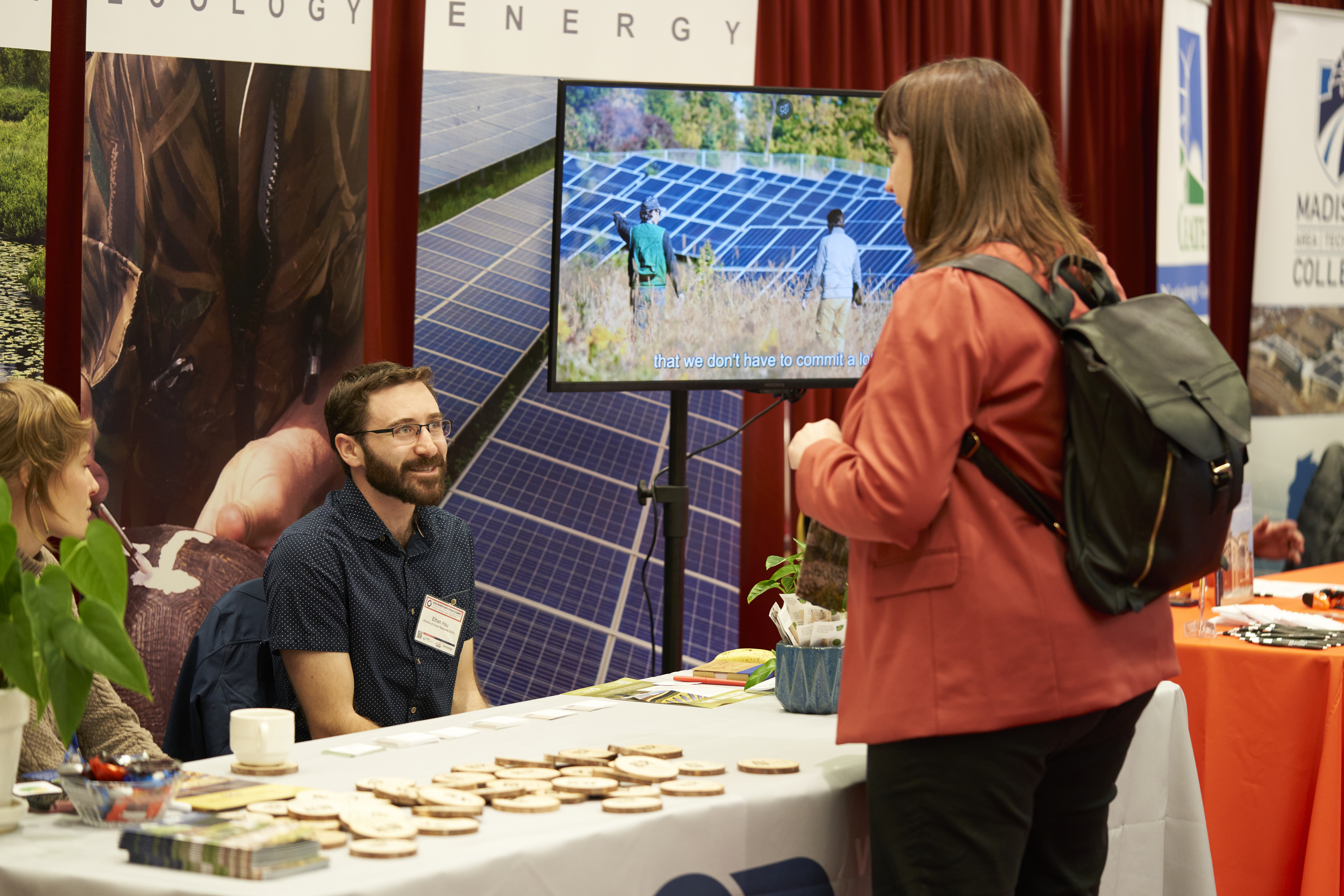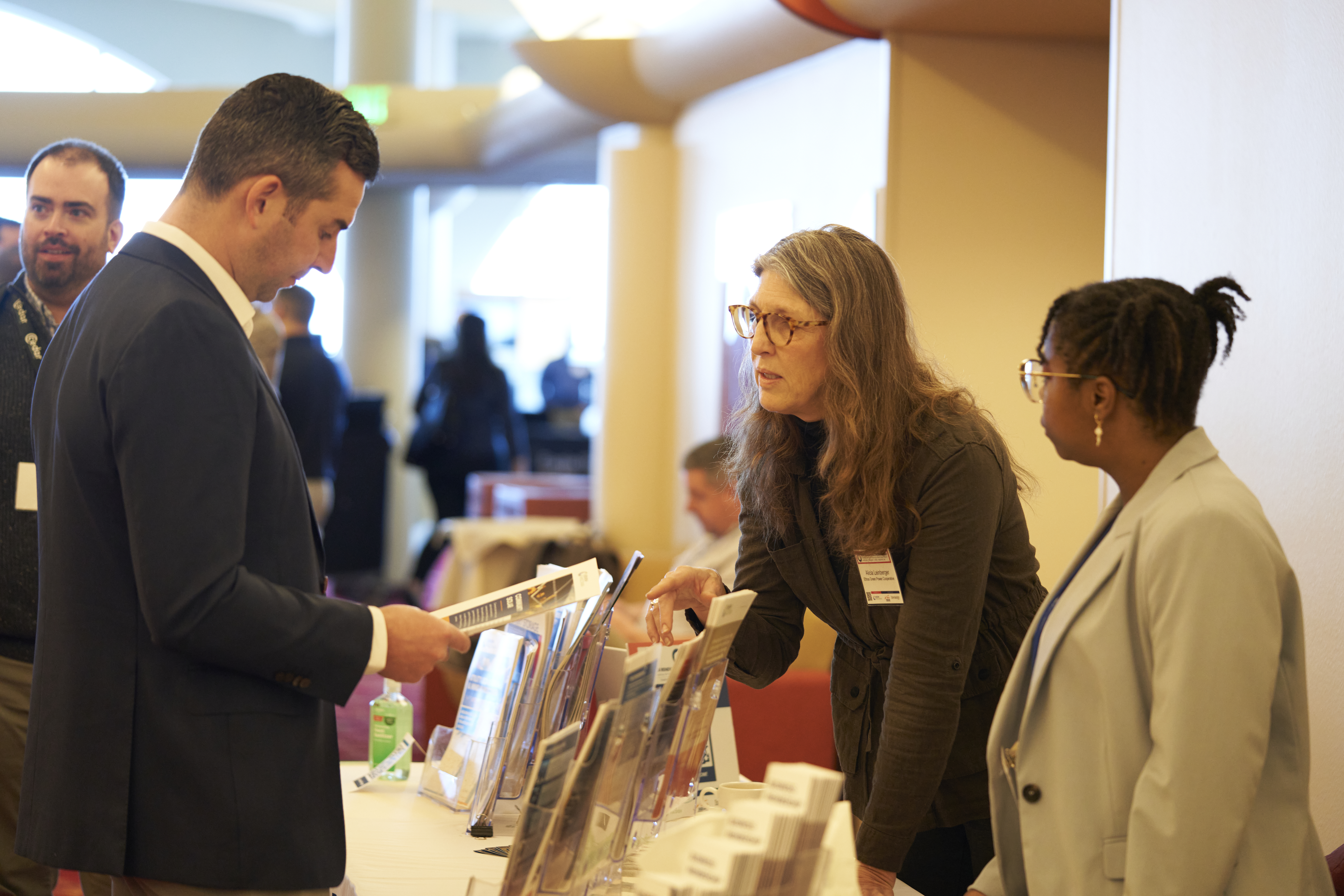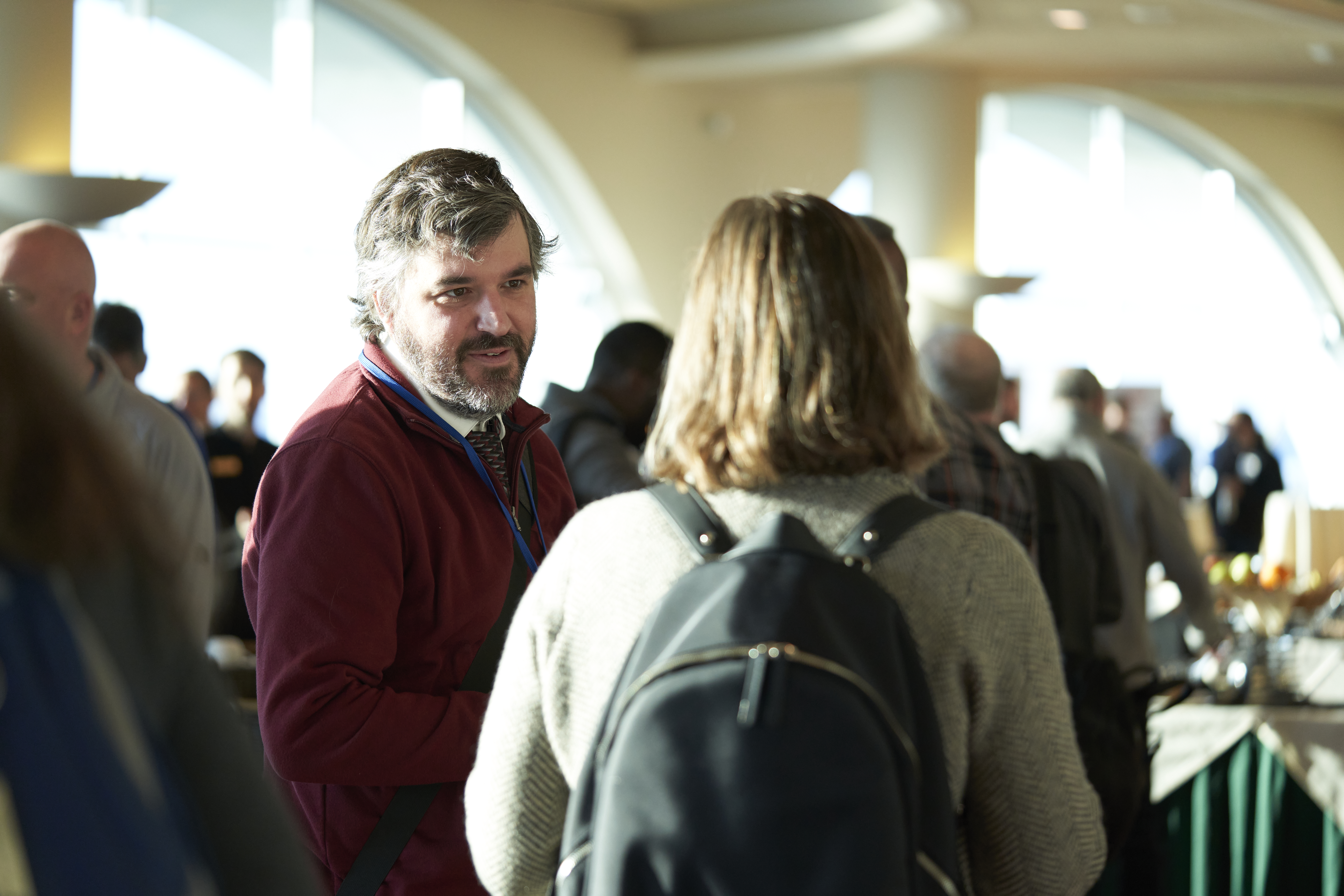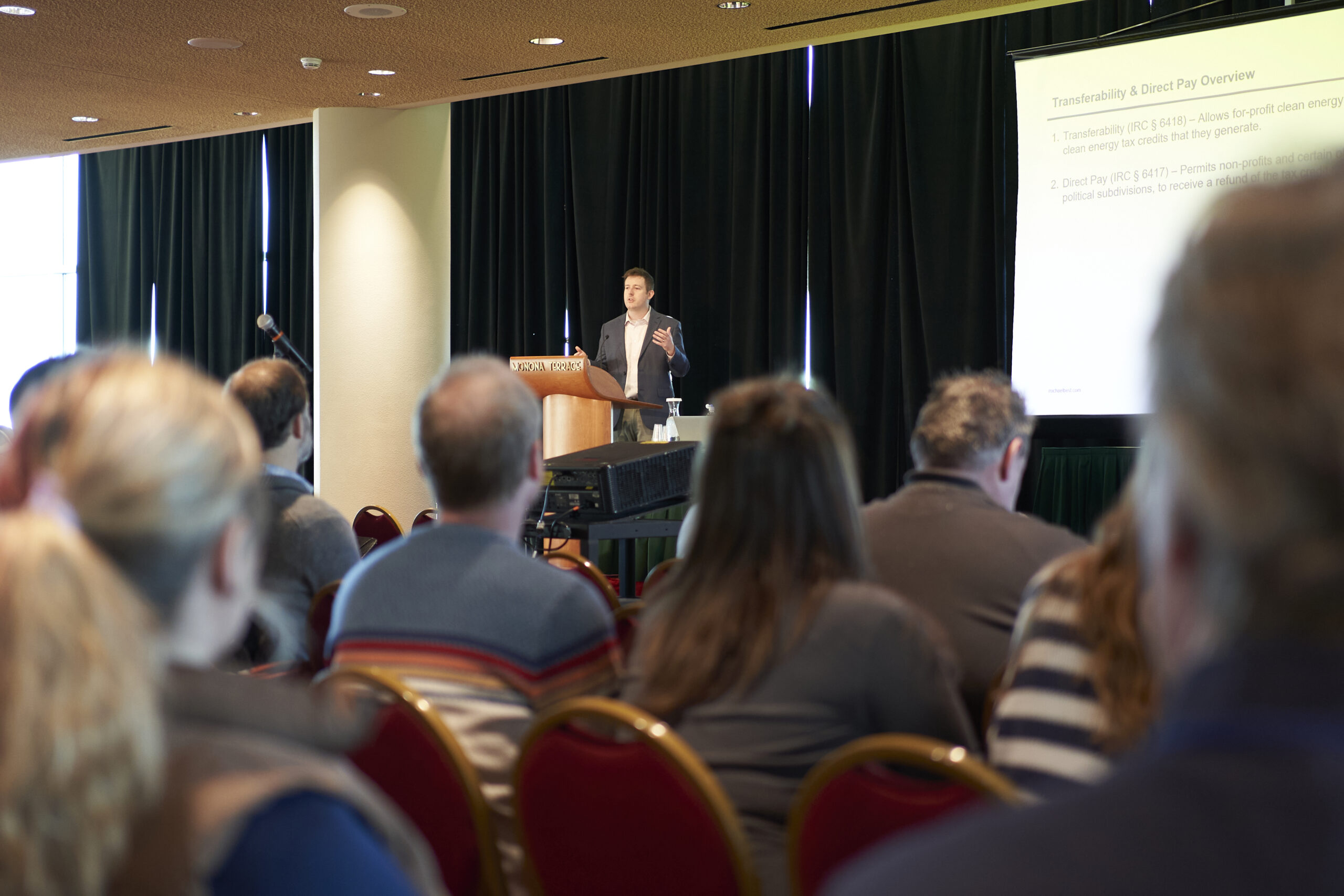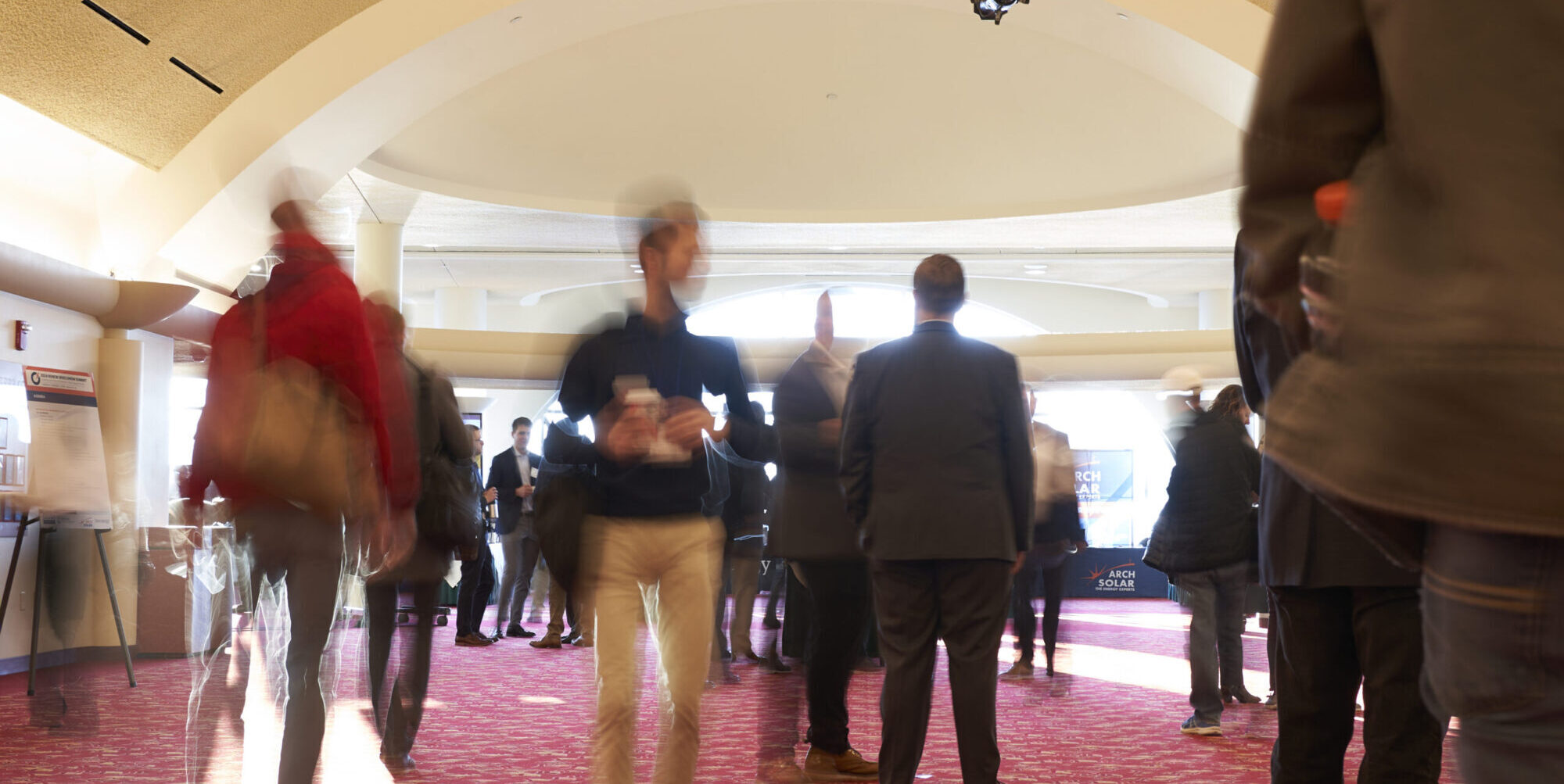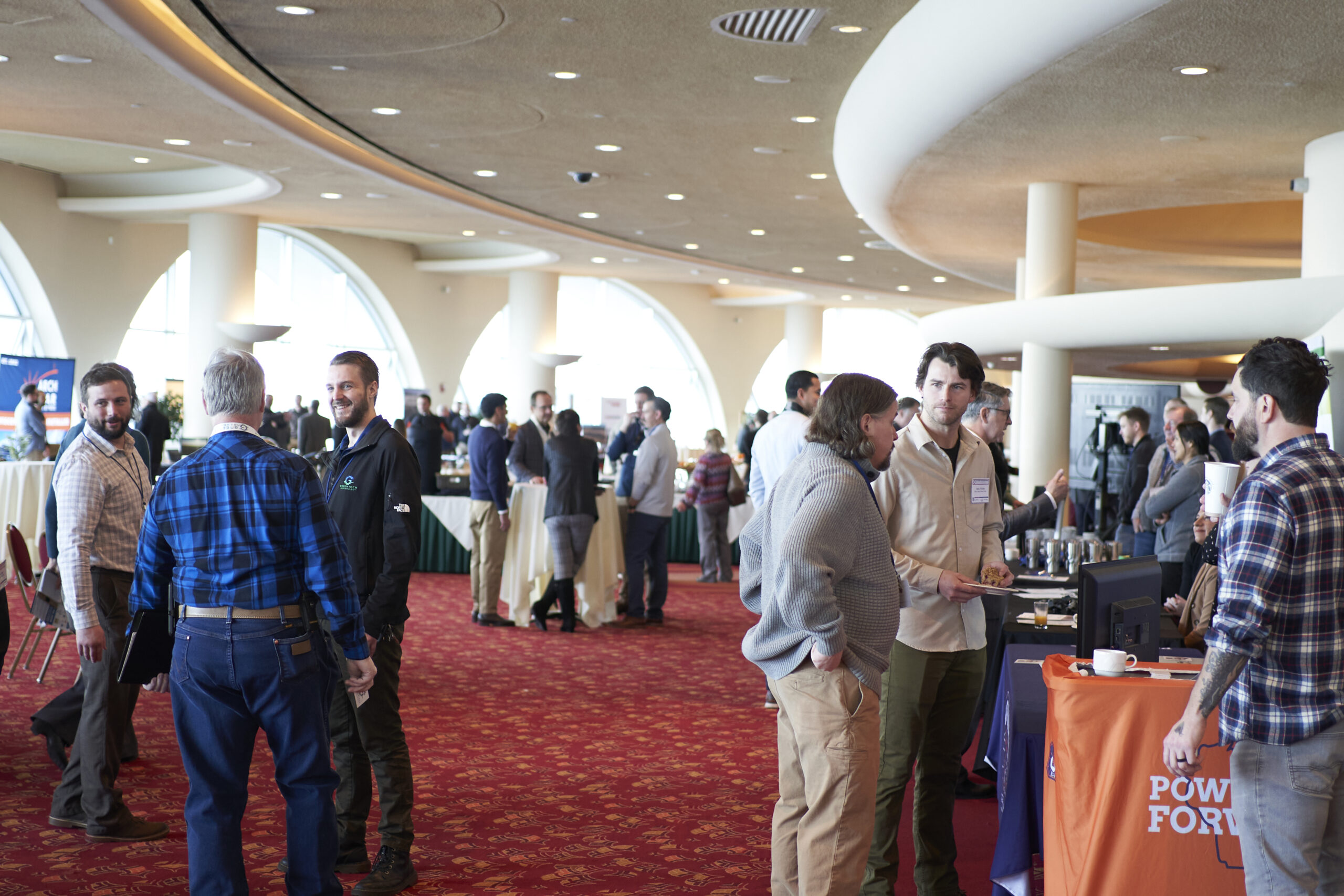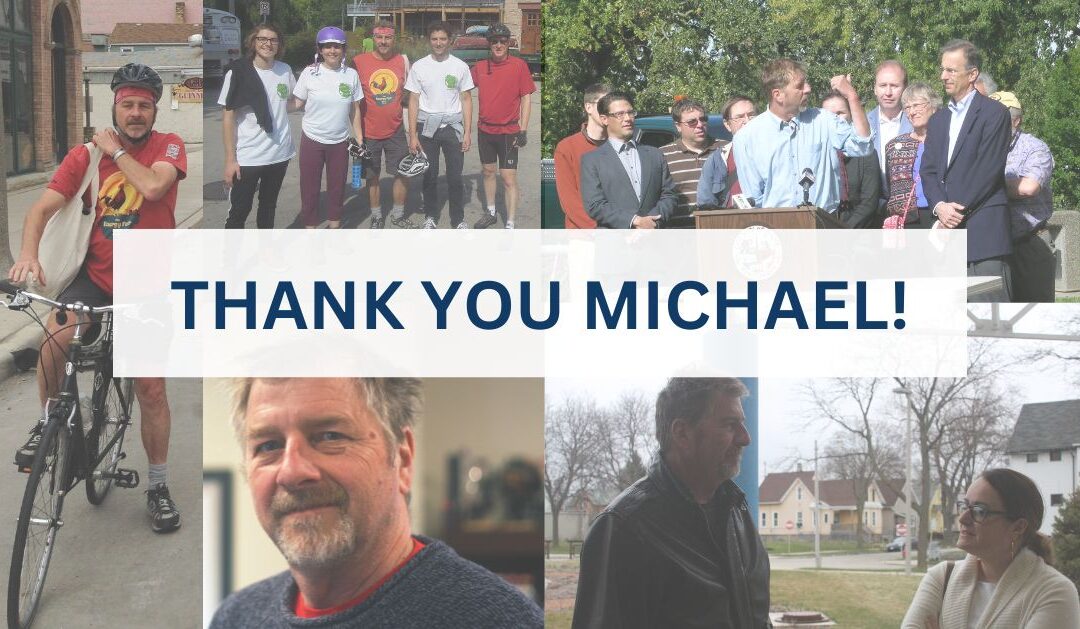
by Alex Beld | Apr 22, 2024 | Press Release, RENEW Wisconsin
After a long career at RENEW Wisconsin, advocating for renewable energy across the state, Michael Vickerman has announced his retirement effective April 20, 2024. Vickerman’s professional legacy spans over 33 years and demonstrates his tireless commitment to Wisconsin’s clean energy transition.
Vickerman got his start at RENEW after responding to a classified ad for a limited-term program coordinator at the nonprofit. For eight years, he served as the sole employee of the organization. He was pivotal in shaping renewable energy policy and fostering collaboration among industry stakeholders.
“No individual has done more to advance renewable energy in the Badger state than Michael Vickerman,” said Sam Dunaiski, Executive Director of RENEW Wisconsin. “He has ushered advocates and professionals through every Wisconsin clean energy challenge and success over the past thirty years. His knowledge, patience, humor, and guidance are unmatched and will be missed at RENEW.”
During his three-decade stint with RENEW, Vickerman held several positions within the organization, serving as Executive Director, Program and Policy Director, and most recently, Clean Energy Deployment Manager.
“Though we’ve had our ups and downs, renewable energy continues to grow in ways that benefit farmers, businesses, communities, and taxpayers,” Vickerman said. “During the early years, it would not have been possible to foresee a future when every power plant in Wisconsin energized in one year would be powered by sunshine and wind energy. But that’s exactly what happened in 2023. Would that have been possible without RENEW’s advocacy over the years and decades? I doubt it.”
“As RENEW has expanded from a single employee to a 13-person staff, our ability to influence and shape state energy policy continues to grow,” Vickerman said. “It will be sad to part company with such a talented group of colleagues, but I have every confidence in their capacity to meet the challenges that lie ahead.”
Vickerman will remain connected to the nonprofit as a member of the board of directors. In his new-found free time, he plans to raise a new puppy with his wife Pamela, garden, and ride his bike around Madison while sustaining his connection to Wisconsin’s renewable energy community.
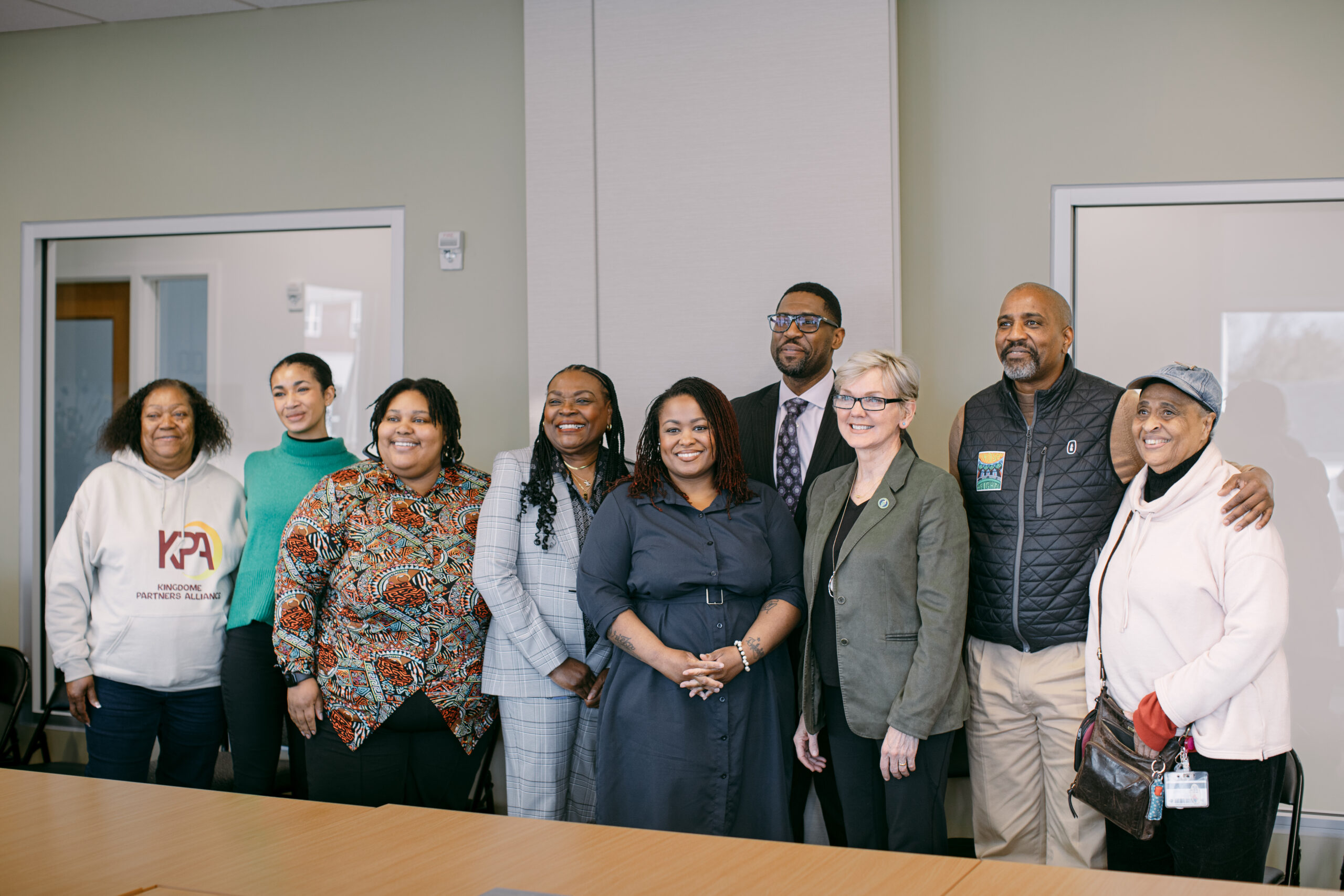
by Aisha Anderson | Mar 28, 2024 | Community, Events, Inflation Reduction Act
On Wednesday, March 27, Walnut Way welcomed the U.S. Department of Energy (DOE) Secretary Jennifer Granholm to their site, opening up a conversation about shared priorities in uplifting progress for environmental justice communities and the transformative nature of the DOE’s involvement in helping the country reach decarbonization goals.
“What a massive honor to host Jennifer Granholm to Walnut Way, having the opportunity to showcase the transformational work being done with community-led comprehensive development,” said Antonio Butts, Executive Director of Walnut Way. “Because of the work being done at the DOE, we can use these grants to further the development of our neighborhood and provide green energy opportunities for low to middle-income individuals, sustainably transforming the city one grant at a time.”

Photo Credit: Clean Economy Coalition of Wisconsin
“The Inflation Reduction Act (IRA) and the Bipartisan Infrastructure Law (BIL) are geared towards healing the rift of the past,” said Granholm. “We want to emphasize and empower communities to have a voice. This can be seen through grant stipulations such as the Community Benefits Agreement (CBA). With the CBA, we wanted to provide a vehicle to empower communities to speak and be heard.”
During her visit, Secretary Granholm participated in a roundtable facilitated by Butts. While leading the roundtable, Butts outlined Walnut Way’s work to elevate the voices of those in the community who haven’t previously had a seat a the table for environmental justice work and the community impact of helping weatherize and install renewable technology on homes in the neighborhood.
Granholm heard several concerns from Butts and others. In her response, she emphasized an upcoming IRA program to help low to moderate-income households with appliance rebates.
“But what we’re going to need is we’re going to need partners on the ground to be able to get the word out to people so they know that these are going to exist,” Granholm said. “Now, it comes through the state and Wisconsin has pledged to by June to roll out their program.”
Granholm shared that the program, for example, might be able to help people replace a worn-out furnace or air conditioning unit with a more expensive heat pump — a more efficient device that transfers energy instead of mostly producing it with fossil fuels.
Butts said the conversation was productive and noted that initiatives from the DOE and programs implemented through the IRA are key in accelerating clean energy solutions — specifically for low and moderate-income people.
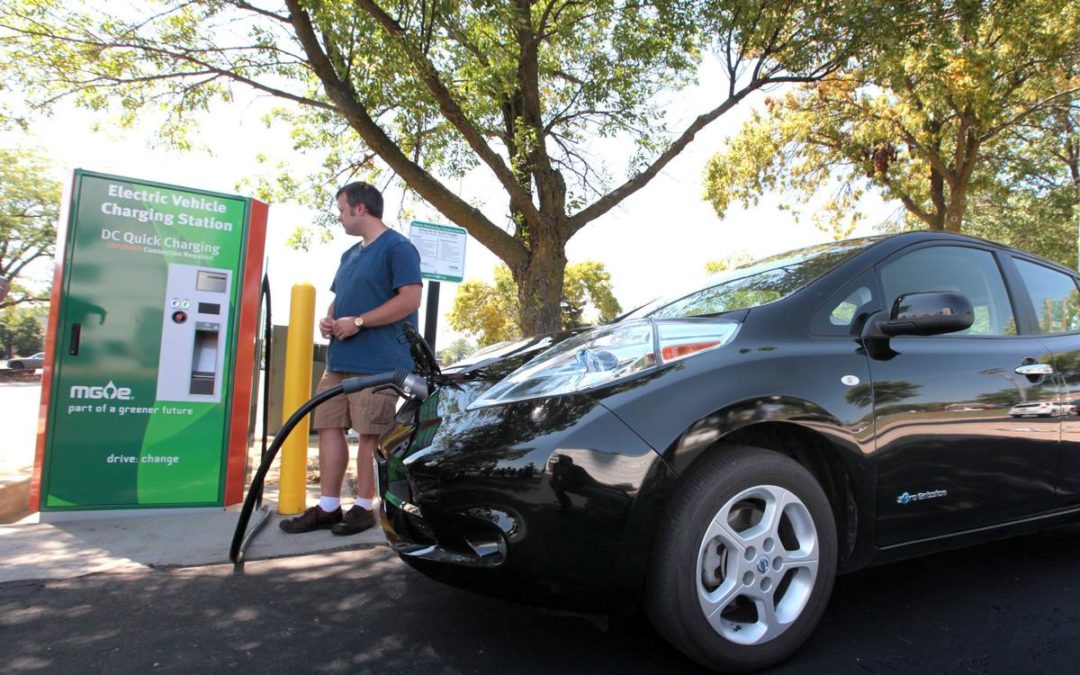
by Orrie Walsvik | Mar 14, 2024 | Electric Vehicles, Electrification, NEVI, RENEW Wisconsin
On March 12, 2024, the Wisconsin State Senate passed Bills 791 and 792, allowing electric vehicle (EV) charging stations to charge by unit of electricity instead of time spent charging. The bill helps provide clean energy access to all Wisconsinites and is a testament to Wisconsin’s commitment to embracing new, proven clean energy technologies. The new law addresses several critical areas to standardize EV usage and infrastructure deployment for private developers. Let’s dive into some of the key parts.
NEVI Funding Unleashed
The cornerstone of the bill is the activation of National Electric Vehicle Infrastructure (NEVI) funding for “Level 3” fast chargers. This funding, totaling a substantial $78 million of federal dollars for Wisconsin, will be channeled toward the building, operation, and maintenance of fast-charging stations across the state. These fast chargers, capable of significantly reducing charging times for longer trips, are vital for reducing range anxiety.
Charging All Over the State, Not Just in Cities
NEVI funding also avoids putting the cart before the horse by providing charging stations across the state, along highway routes for the next five years, paying for the cost of the station, the operations, and the maintenance. Check out the map below to see the routes.
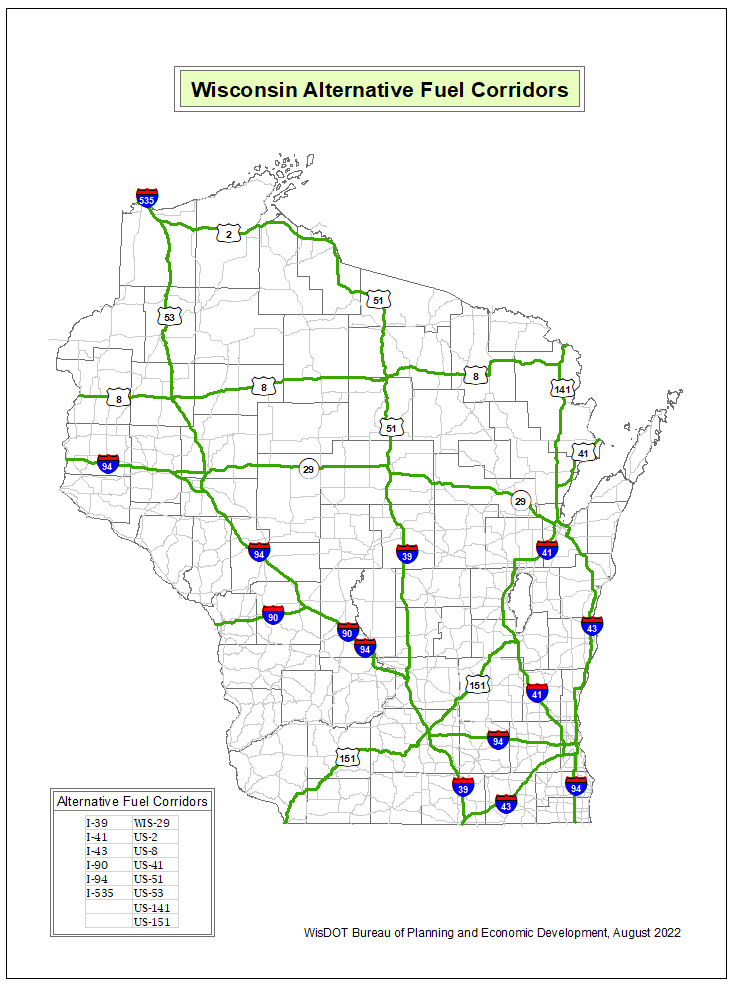
Jobs, Training, Reliability & Safety
But the bill doesn’t stop there. It also emphasizes the importance of training, ensuring that those responsible for these chargers are equipped with the skills necessary to maintain their reliability and safety. Chargers must be operable at least 97% of the time to receive the funding. This commitment to training not only boosts job opportunities but also ensures that the infrastructure remains robust and dependable.
Protects Level 1 and Level 2 Chargers
The Legislation clarifies that residential Level 1 and Level 2 chargers are clear of tax and regulation. It also provides regulatory certainty for groups looking to install public level 1 and level 2 chargers to avoid classification as a public utility, clearing up a large regulatory hurdle for EV Charging implementation. This protection ensures that these residential and light commercial chargers have a realistic path forward in Wisconsin. This move is a win for EV owners and businesses alike, fostering a more flexible and user-friendly charging landscape.
Tax and Road Fund
A tax, similar to the gas tax, of 3 cents per kilowatt-hour (kWh) of electricity used for charging will be implemented for public EV chargers. This measure brings EVs in line with gas and diesel cars. Charging by the kWh also ensures customers pay for the amount of fuel received instead of the amount of time spent charging, a policy that favored individuals with more expensive cars. Now, all users will pay a fair price for their power and end the inequity of time-based charging. Unfortunately, EVs are still required to pay $175 for registration, $75 more than fossil fuel cars.
This bill pairs regulatory certainty for charging station owners with equitable locations and rates for EV drivers. The bill also clarifies how and when local governments can own EV charging stations, and does not effectively change the situations of previously existing chargers.
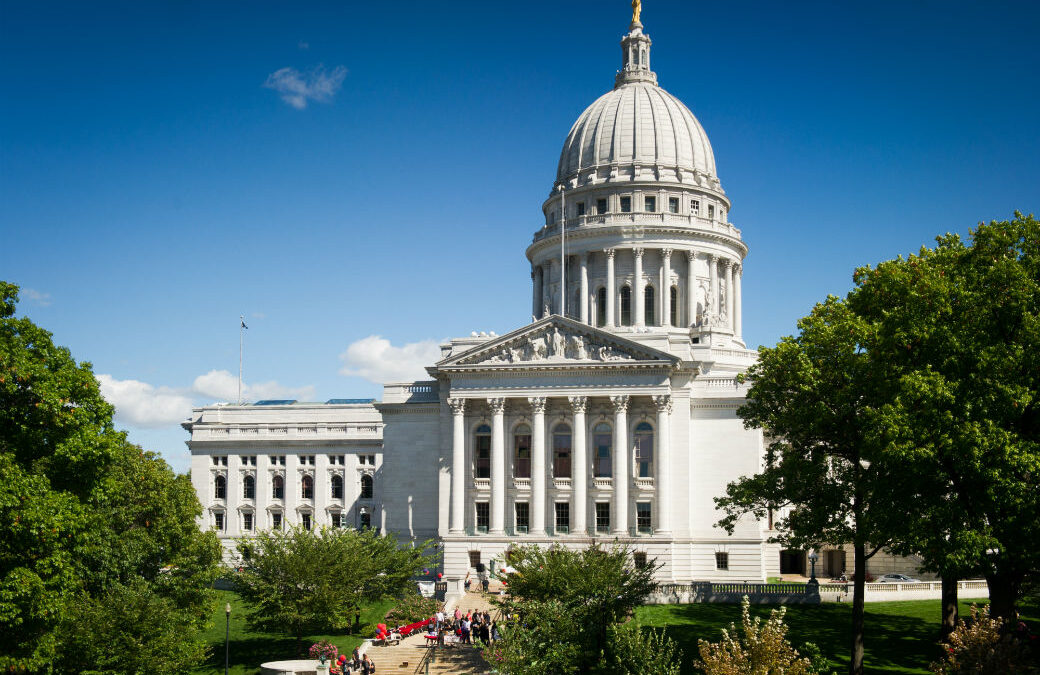
by Beata Wierzba | Mar 14, 2024 | Advocacy, Electric Vehicles, Legislative Watchlist, Local Government, NEVI, Solar
As the legislature wraps up for this session, RENEW is celebrating several victories and reflecting on some of the other renewable energy measures being considered by the state legislature.
Big Win for Electric Vehicle Infrastructure
Senate Bill 791, the Electric Vehicle Charging Bill, passed the legislature with several amendments. The legislation exempts private entities that develop charging stations from being regulated as a public utility but allows them to measure the cost of electricity used for charging EVs by the kilowatt hour (kWh). Establishing this new kWh standard to calculate how much electricity is used, rather than how long it takes to charge the vehicle, provides an essential uniform requirement for the industry. It is also required by the National Electric Vehicle Infrastructure (NEVI) Program for Wisconsin to qualify for $78 million dollars in federal funding, an 80% cost share, for level 3 chargers to build corridors for charging. RENEW will be developing a detailed overview of the passed legislation for those interested in more information. The bill received bipartisan support and limited opposition. In other actions related to electric vehicles, the Legislature also passed SB 792, which establishes the infrastructure program and enables the state to utilize the federal NEVI funding. Additionally, with the passage of SB 617, the DOT will issue registration plates or stickers for existing license plates that indicate the vehicle is electric.
Progress on Community Solar
The community solar bill, Assembly Bill 258, did not pass either the Senate or Assembly but did get a hearing in the Assembly Committee on Energy & Utilities. This is a significant development considering the heavy opposition from Wisconsin Utilities. The public hearing was a great opportunity for the benefits of community solar to be shared with state legislators. During the hearing, supporters of community solar were able to answer questions, correct misinformation, and show their unity and strength. Establishing a community solar program for renewable energy generation is essential for those without the option to install panels on their own roofs, or the financing necessary to cover costs. Under the community solar arrangement, the participants subscribe to the developed project and receive a credit on their electric bill for solar electricity generated on panels installed in a community setting. The developer arranges permitting, financing, and installation, as well as maintenance. If passed, the legislation would require approval of the location by local governments and be limited to 5 megawatts or about 26 acres. Each project would also require at least four subscribers. With fierce opposition in some areas to larger utility-scale operations, the community solar model is a better fit.
Other Legislative Wins
There were numerous bills that aimed to limit renewable energy development, including restrictive sitting and increased regulation. They did not pass, and in most cases, did not receive a hearing. These bills ultimately died in committee.
Assembly Joint Resolution 6
Assembly Joint Resolution 6 (AJR6) would give the Wisconsin Legislature control over how federal funds are spent, rather than the Governor, on behalf of the state. Recent examples of federal funds distributed to the states include the Inflation Reduction Act (IRA) and the Bipartisan Infrastructure Law (BIL), both have benefited Wisconsin’s clean economy. The Wisconsin constitution directs the Governor, as head of state, to oversee disbursement. In order to change the constitution, identical legislation has to pass the legislature twice in a row and then be considered by state voters. Because it is not regular legislation but a joint resolution of the legislature, the Governor does not have veto power. After the passage, the resolution language will become the referendum during an upcoming election, with the resolution language being the exact question asked. If voters approve the referendum, the state will need to modify the constitution. The consequences of this change can impact many efforts, such as conservation measures, disaster relief funds, higher education, and more. The earliest statewide election when this referendum can be placed on the ballot is the August primary. Efforts are on the way to provide information and educate the voters on the impact the change could have on issues of importance to them.
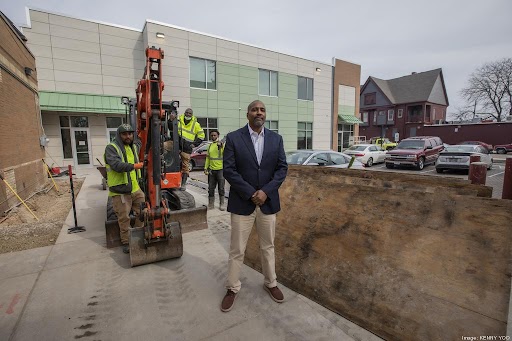
by Aisha Anderson | Feb 26, 2024 | Community, Community Change Grant, Inflation Reduction Act
Photo Credit: Walnut Way
Walnut Way, Community Change Grants and how their benefits can be leveraged to reduce environmental disparities in Milwaukee’s Northside
Clean energy dollars are reaching Milwaukee’s most underserved communities thanks to federal funding through the Inflation Reduction Act (IRA). With over 20 years of experience as an environmental nonprofit in Milwaukee’s northwest side, Walnut Way Conservation Corp. has established itself as a trusted resource for Lindsay Heights residents and statewide organizations through its commitment to creating healthier, safer, and more prosperous communities.
One of the ways this will be done is by the creation of a one-megawatt microgrid within the Lindsay Heights community. This will support the integration of clean energy into the electricity grid and protect grid reliability.
These place-based investments will be focused on initiatives led by the community members of Lindsay Heights, ensuring they are responsive to the community. They are designed to deliver on the transformative potential of IRA for communities most adversely and disproportionately impacted by climate change, legacy pollution, and historical disinvestments.
Antonio Butts, executive director of Walnut Way, said, “Over the past two years, significant work has been done in Milwaukee to address energy burden, energy affordability, and sustainability projects in underserved communities. This work has involved engagement in utility rate cases with the Public Service Commission of Wisconsin, cross-sector collaborations with local grassroots organizations, and partnerships with various state agencies.”
Through the EPA’s new Environmental and Climate Justice Community Change Grants, Walnut Way has the opportunity to move forward with its multi-million dollar proposal intended to advance sustainable change. The Community Change Grants, which were developed as a comprehensive response to pressing environmental concerns, leverage the collective strength of Walnut Way and its partner organizations by deploying a budget of approximately $20 million to be distributed over 36 months. Walnut Way’s proposal is specific to Milwaukee’s Lindsay Heights Neighborhood with the goal of increasing education, capacity building, governance participation, and environmental stewardship. The goal is to reduce the energy burden within the community and promote renewable energy sources among residents.
Overall, the project aims for a holistic transformation of urban infrastructure and the creation of a sustainable, equitable community.
Community Impacts: Direct Financial Assistance, Energy Independence, and Home Weatherization
“This grant opportunity is designed to fund community-driven projects that address environmental and climate challenges and enhance meaningful involvement in government processes related to environmental justice,” said Butts.
For Walnut Way, this starts with direct financial assistance to Lindsay Heights residents. The budget for the proposal outlines $3 million in direct assistance over three years to alleviate financial burdens associated with the cost of food, medical supplies, energy-efficient appliances, and utility bills.
Walnut Way has budgeted an additional $2 million to extensively weatherize 300 homes in the community. Weatherization services include upgrading appliances such as stoves and refrigerators to more energy-efficient models, installing heat pumps, and updating roofing in preparation for solar panel installation.
More notably, the initiative has allocated $1.5 million to implement a 0.5 MW microgrid for subscription-based renewable energy access. This project has been created to mitigate the high electricity bills and disconnection performed by the local utility company and will be done in partnership with Watts Up Way, an apprenticeship program born out of Walnut Way to support a clean energy transition, enhance energy independence within the community, and promote clean energy jobs.
To reduce the energy burden of residents, Walnut Way has budgeted $2 million to weatherize 300 homes in the community.“Our goals are ambitious,” Butts said, “And in order to complete these goals, it’s going to take a collective effort. Our objective is to sustain our engagement and ensure that generations to come have a voice that directly impacts our well-being and quality of life.”
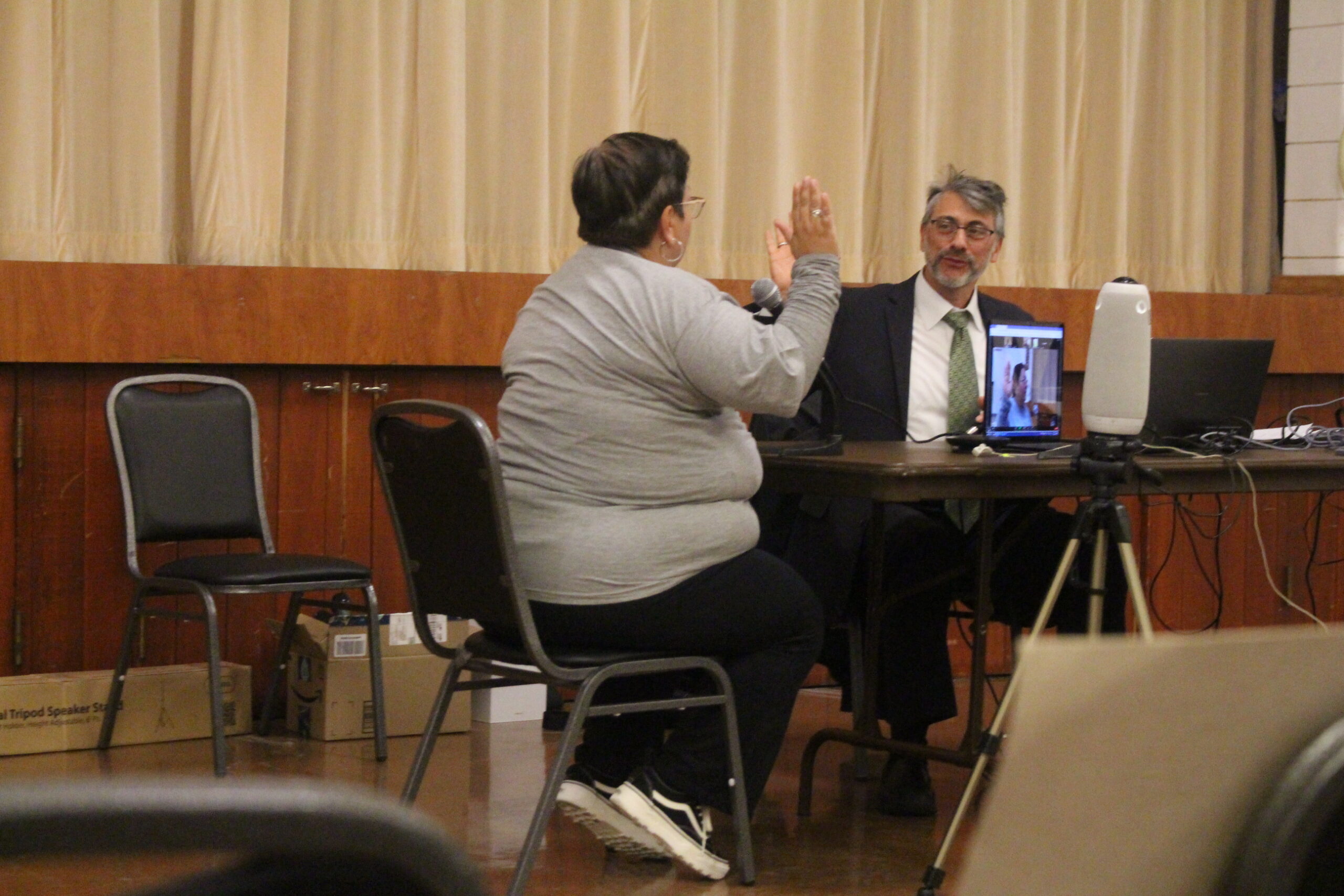
Photo Credit: Walnut Way
The Importance of Community-Led Transitions to Energy Justice
A critical element of this effort is the Resilient Resident Civic Engagement Compensation Program. This innovative program by Walnut Way provides a strategy for community members to gain recognition and compensation for their contribution to the project, providing a way to earn additional income and engage in civic activities.
The objective of this is to provide an avenue for transparent two-way communication, leadership, and adjustment between government entities and constituents to build trust within the community. For Walnut Way, community engagement has always been the foundation for achieving sustainable change. This is apparent in conversations among Walnut Way and Lindsay Height’s residents when asked about their vision for the community moving forward.
The desire for change among residents is not scarce, but the means to make improvements have been.
“The reality is that we need to take advantage of all available resources,” Butts admitted, and “especially listening to our community members. They live here. They know what they need to be successful.”
He continued, “Being held accountable by the residents requires us to be aligned, coordinated, and to already have established a baseline of accomplishments for us to earn their trust.”
“Working alongside residents enables us as an organization to respond with confidence to aid the community moving forward,” Butts said.
Emmonia Barnett, who has lived in Lindsay Heights for over ten years, shared, “My vision is a community that is empowered to look after itself.”
Her neighbor, Ammar Nsoromoa, echoed Barnett’s wishes and added, “I would like the community to be beautiful. You don’t see trash. You don’t see people in poverty. The community is self-sustained. We take care of one another. The businesses serve the locals. We feed each other with food from grocery stores in our neighborhood. We want to be actively a part of what’s going on.”
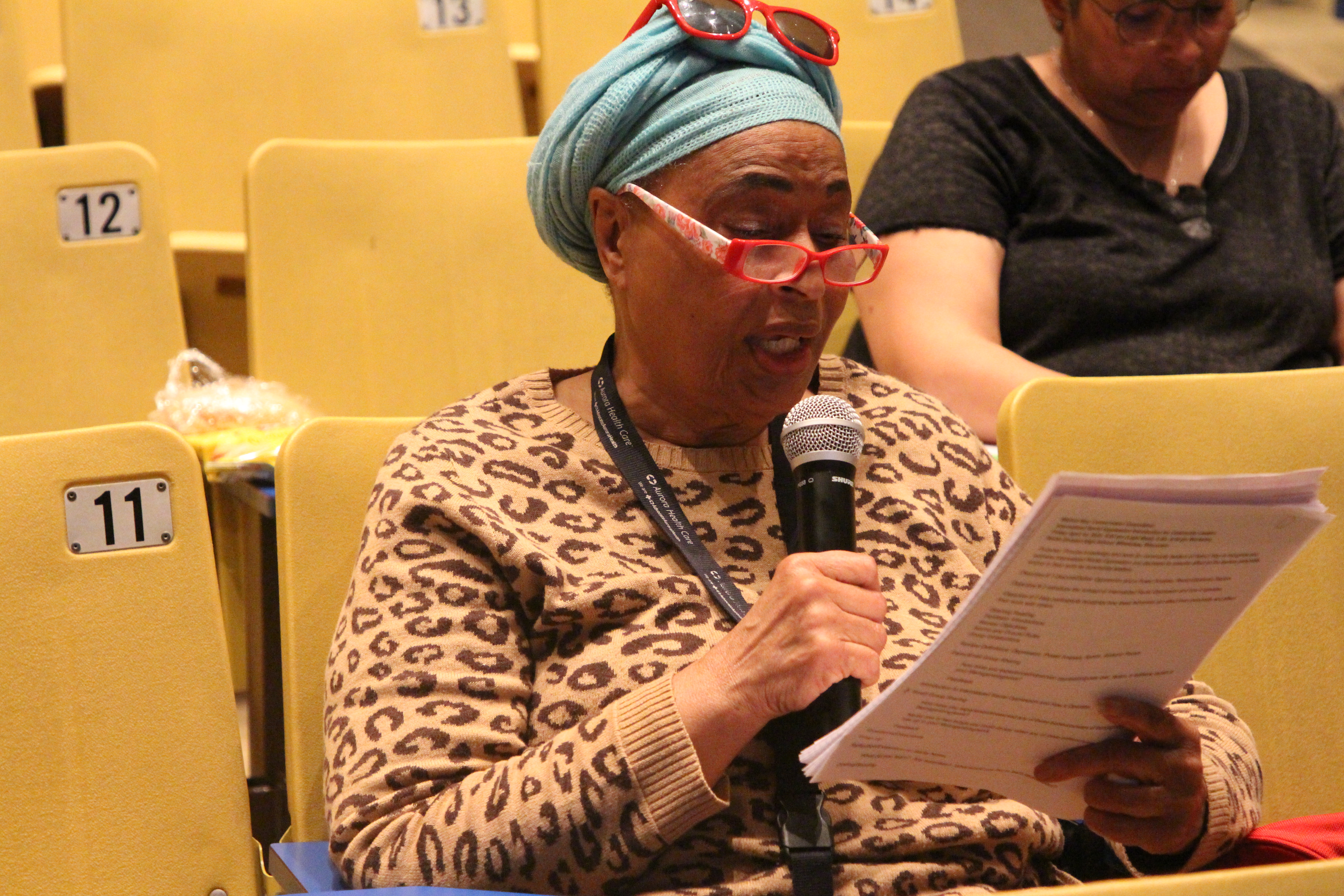
Photo Credit: Walnut Way
EPA Grant deadlines, technical support, and how to bring change to your community
While Walnut Way is still in the preliminary stages of the grant application, the Notice of Funding Opportunity is open now through November 21, 2024, with applications accepted on a rolling basis. Additional support for organizations and communities seeking technical assistance with grant eligibility and technical writing will be provided through the EPA’s Environmental Justice (EJ) Thriving Communities Technical Assistance Centers (TCTAC). The creation of these centers was a direct response to feedback from overburdened communities and organizational leaders who have encountered barriers to maximizing the full benefits of available federal funds.
There are the two TCTACS serving Region 5 organizations and communities that have been disproportionately impacted by environmental hazards. As designated by the EPA, Region 5 spans 35 tribal lands and six states–Illinois, Indiana, Michigan, Minnesota, Ohio, and Wisconsin. The Great Lakes, led by the University of Minnesota, and Blacks in Green (BIG) Justice, led by a partnership of community-based organizations in Illinois, are the two TCTACs that serve Region 5. Interested applicants can submit an intake form detailing their needs to either center to get help with overcoming barriers to accessing funding from the Community Change Grants.
“Our objective is to sustain our engagement and ensure that generations to come have a voice that directly impacts our well-being and quality of life,” Butts said.
He also noted that the Community Change Grants program has the capacity to expedite this process for the residents of Lindsay Heights while allowing the community to lead in its own solution development towards the clean energy transition.
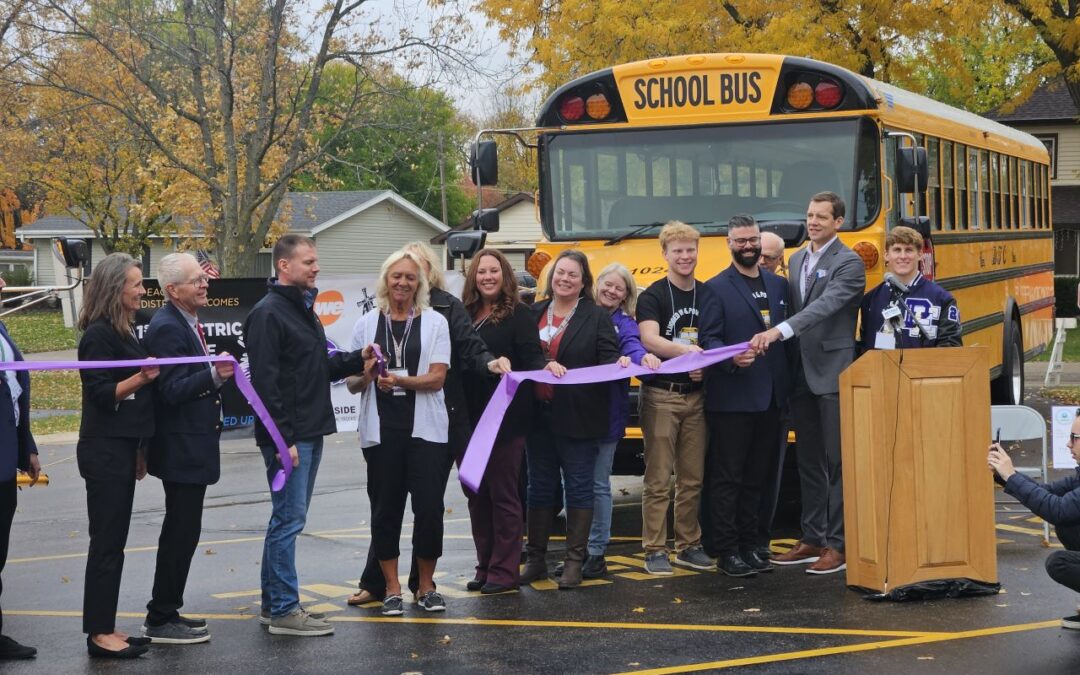
by Alex Beld | Feb 23, 2024 | Electric School Bus, Electric Vehicles, Electrification, RENEW Wisconsin
“About six years ago, this school district was on the verge of dissolving for a variety of reasons,” said Dr. Ryan Krohn, district administrator. “When we doubled down our efforts as a board to stay open, we said we’d invest in innovation and sustainable efforts.”
In the fall of 2022, the district applied for the Clean Bus Program Grant through the EPA, funded by the Bipartisan Infrastructure Law. As they charted their path forward, the leaders of the Palmyra-Eagle Area School District had to shift their thinking about the future, which ultimately led to electric buses.
When the school district learned about the EPA grant, they brought the idea of transitioning to electric buses to the school board. Together, district leaders and the board looked at how this change aligned with their goals of safe, healthy, and effective schools.
“We knew it was going to require new thinking, new experiences, and ultimately, we looked at this as a starting spot to transform our system,” Krohn said.
When considering the transition to electric school buses, the district looked at efficiencies that would be gained, not only in terms of the costs from fuel savings but also in terms of health, safety, and the environment. Addressing these aspects required the district to strengthen and build new partnerships with key stakeholders. This included energy utilities, local police, the transportation company they work with, and many other partners. Thanks to the support they received in return, they became the first school district in Wisconsin to start using electric buses to transport their students.
“There’s no way our school district, being led by someone like myself, was going to be able to be able to pull this off (alone),” Krohn said .”My background is not in this.”
The district was ultimately awarded $2 million dollars, enough for six electric school buses. Since receiving the buses, Ryan has been participating in webinars and other events to share the story of Palymra-Eagle’s journey. That journey and the connections they made along the way have led to the district leaders altering how they look at their 10-year capital plan. It has also led to greater engagement with the community.
“Our recent efforts, just because of this, ended up in our community donating money for a new greenhouse,” Krohn said. “We have a strong agricultural program in our school district.”
Both the electric school buses and this new greenhouse serve as educational tools for the students of the Palymra-Eagle School district. As Dr. Krohn said, it also empowers their students and engages them in thinking about the shifts that need to happen for our energy future.
by Alex Beld | Feb 14, 2024 | Community, Events, RENEW Wisconsin, Renewables
RENEW Wisconsin selected 13 projects for this year’s Honor Roll. These projects and the organizations involved in them demonstrate leadership, ambition, and climate awareness in their design and use of clean energy.
ALLIANT ENERGY (WPL) SOLAR PORTFOLIO
In 2023, Alliant Energy’s Wisconsin utility placed in service eight utility-scale solar plants totaling 639 megawatts as part of its Clean Energy Blueprint. By the end of the year, Alliant had finished work on 11 of the 12 projects in its solar portfolio. When the final solar plant is completed this summer, they will together generate approximately 20% of Alliant’s resource mix in Wisconsin, sufficient to power nearly 300,000 homes annually. Many Wisconsin contractors participated in the construction of these projects, including Westphal Electric and Mashuda Contractors.
BADGER HOLLOW
Developed by Invenergy and owned by WEC Energy Group and Madison Gas and Electric, Badger Hollow Solar Park is now fully operational. At 300 MW, it is Wisconsin’s largest operating solar power plant, capable of generating 6,000,000 megawatt-hours per year. This is equal to the annual consumption of 90,000 Wisconsin households. Badger Hollow was one of the first utility-scale solar plants approved by the Public Service Commission in 2019. Since then, Invenergy has secured permits for four more solar and storage projects in Wisconsin, totaling 1.35 gigawatts. Two of them are under construction today.
BAYFIELD COUNTY
Bayfield County successfully commissioned the area’s first multi-building, intelligent microgrid on November 10, 2023. The Bayfield County Courthouse and Jail automatically integrate solar PV, battery storage, and backup diesel generation under a single utility meter. The system will provide electric power with or without the electric grid and can optimize economic benefits during normal grid-tied operation through features like demand management and energy arbitrage. The system is not only a first for the area but a first for Wisconsin and the Midwest.
CITY OF MADISON
In the previous decade, the City of Madison set a goal of installing one megawatt of solar capacity by 2020 to supply its own facilities. By the end of 2022, about 1.5 MW of behind-the-meter solar power had been installed, mostly through the City’s Green Power training program. In 2023, the City added 585 kW of solar PV at nine different facilities, including 200 kW apiece at both Streets West and the Nakoosa Rd. Fleet Garage, bringing overall installed PV capacity serving City facilities to more than 2 MW.
COLLEGE OF MENOMINEE NATION
In 2023, Eland Electric partnered with the College of Menomonee Nation to install a 40-kilowatt solar array on the tribe’s reservation in Keshena. In addition to powering a college building, this array kicks off an initiative to help local community members develop the skill set needed for installing and maintaining solar arrays. The Menomonee Nation hopes to build its own reservation-wide solar energy utility service.
HOLY WISDOM MONASTERY
In 2023, Holy Wisdom embarked on an ambitious effort to become an all-electric facility using carbon-free sources onsite to the greatest extent possible. The monastery’s journey to a carbon-free future began with a significant expansion to the onsite PV capacity already in place. Designed by the team of Hoffman Planning and Madison Solar Consulting and installed by Northwind Solar, the new array is built upon single-axis trackers, and its output flows directly into the utility distribution system. When the ground-source heat pump and battery storage system are commissioned later this year, Holy Wisdom Monastery will have effectively achieved carbon neutrality. Wisconsin’s Office of Energy Innovation helped kick off this project with a $575,000 grant awarded in 2021. Local solar developer John Young contributed financing for the solar array.
MCFARLAND PUBLIC SAFETY BUILDING
In 2023, the village of McFarland celebrated the opening of its new Public Safety Center, likely the first net-zero municipal building in the state of Wisconsin. With 51 geothermal wells for efficient heating and cooling as well as solar panels that can produce up to 470kW of photovoltaic energy, the facility will produce as much energy onsite as it consumes annually, leading to its designation as a net zero facility. Taking advantage of federal and state clean energy funding (including an Energy Innovation Grant), this $20 million building should pay for itself in year one.
RED BARN WIND ENERGY CENTER
Commissioned in 2023, the 92 MW Red Barn Wind Park was developed by Minnesota-based PRC Wind and built by Allete Clean Energy for the project’s current owners, WEC Energy Group and Madison Gas and Electric. Approved by Grant County in 2019, Red Barn is the first project in Wisconsin to have advanced from the proposal stage to full operation under the state’s Wind Siting Rule (PSC 128). The output from this 28-turbine project should equal the annual consumption of 50,000 Wisconsin households.
SHEBOYGAN SENIOR COMMUNITY
Sheboygan Senior Community is a faith-based, nonprofit continuum of care facility providing respite, short-term rehab, assisted living, skilled nursing, and end-of-life services. Designed and installed by Plymouth-based Arch Solar, the installation consists of a 198-kW ground-mount solar array and a battery energy storage component. In addition to a grant from the Wisconsin Office of Energy Innovation, the project’s financing relied on a generous commercial benefactor, who provided 95% of the funding for the senior community’s project. The organization worked with Legacy Solar Cooperative to secure this funding. In addition, Couillard Solar Foundation donated one-third of the 438 panels that make up the array.
SOLARSHARE WISCONSIN
In 2023, SolarShare Wisconsin, a cooperative entity organized under Chapter 185, invested capital provided by members to bring two smaller solar projects in western Wisconsin to fruition. SolarShare Wisconsin partnered with OneEnergy Renewables, which has developed more than 20 smaller-scale solar projects across Wisconsin, to build its first two arrays in Juneau County, totaling 4.5 MW. Now energized, the Lemonweir (lemon•weer) and Webster Creek projects supply electricity to Oakdale Electric Cooperative. SolarShare Wisconsin plans to add another solar project to its portfolio later this year. At a site near Lake Hallie (rhymes with rally) in Chippewa County. Like the first two projects, the Lake Hallie project, also developed by OneEnergy, will be financed with capital provided by SolarShare Wisconsin members.
UW-HEALTH EASTPARK MEDICAL CENTER GARAGE
In 2023, UW-Health partnered with SunPeak and Staff Electric to design and oversee the construction of a 1 MW solar parking canopy on the garage adjacent to its Eastpark Medical Center. This PV canopy not only supports UW-Health’s carbon reduction goals but also provides additional protection to patients and visitors using the facility.
UW-PARKSIDE
UW-Parkside partnered with McKinstry to host a 2.1 MW solar array, similar to the one McKinstry designed for UW-Platteville a year earlier. Built on a parking lot, UW-Parkside’s array is the largest installation in 2023 serving a Wisconsin school or municipality. McKinstry selected Westphal Electric to build the structure and interconnect the PV system to the grid. The electricity generated by the McKinstry/Westphal installation flows directly to UW-Parkside campus buildings.
YAHARA SOLAR
As noted on Dane County’s website, the 17-megawatt Yahara Solar project, completed in 2023, enables Dane County to become not only the first county government in the state to achieve 100% renewable electricity status, but also the 4th county in the nation to reach the 100% goal. Key partners in the project include Alliant Energy (the local utility), SunVest (the project developer and owner), and Pieper Power (the installation contractor). Yahara Solar will produce more than 36 million kilowatt-hours of renewable electricity per year — enough to power more than 3,000 Dane County homes.
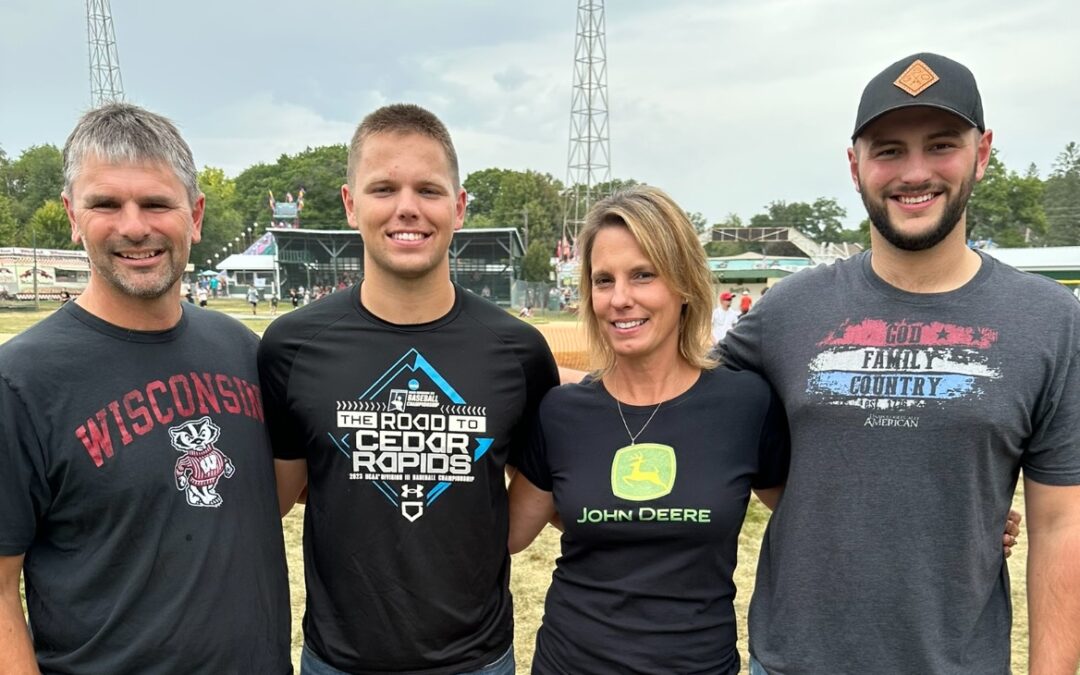
by Aisha Anderson | Feb 9, 2024 | Inflation Reduction Act, REAP, Solar, Sustainable Business, Sustainable Businesses
Photo Credit: Brett Carlson – Owner and Founder of Ag & Business Solar Partners
In 2020, Brett Carlson and his dad, Carl, decided to install solar panels on the farm using the financial support offered through the Rural Energy for America Program (REAP). The complexities of this process inspired the creation of his company, Solar and Ag Business, whose goal is to help farmers and small businesses reap the benefits of solar energy.
The Rural Energy for America Program (REAP) is a federal program that provides financial assistance to agricultural producers and rural small businesses to make the switch to renewable energy. The REAP Grant was established in 2002, and up until 2023, the grant covered 25% of the total project costs. The grant was expanded to cover 40% of the total project cost in early 2023 and then increased to 50% of total project costs thanks to additional funding from the Inflation Reduction Act (IRA). When you factor in tax credits and depreciation, Wisconsin farmers and small businesses can install solar at a fraction of the cost.
Solar energy can reduce energy bills, benefitting the bottom lines for farms and rural small businesses that are often looking for additional efficiencies to help keep their businesses viable.
“Of the many volatile expenses that come with farming, this is one that we can control. The initial overhead cost of installing solar was a barrier that most farmers weren’t able to overcome until now,” Brett said.
The benefits of the REAP Grant to rural America are significant, but the lack of education about solar in rural areas and the complexities of the REAP grant application itself presents a challenge. Brett experienced this firsthand when he helped his parents apply for the REAP grant. Brett explained that he and his parents left that experience feeling frustrated as they were pushed to outsource help for the REAP application to “predatory consultants and grant writers,” who knew that most farmers could not navigate grant jargon on their own.
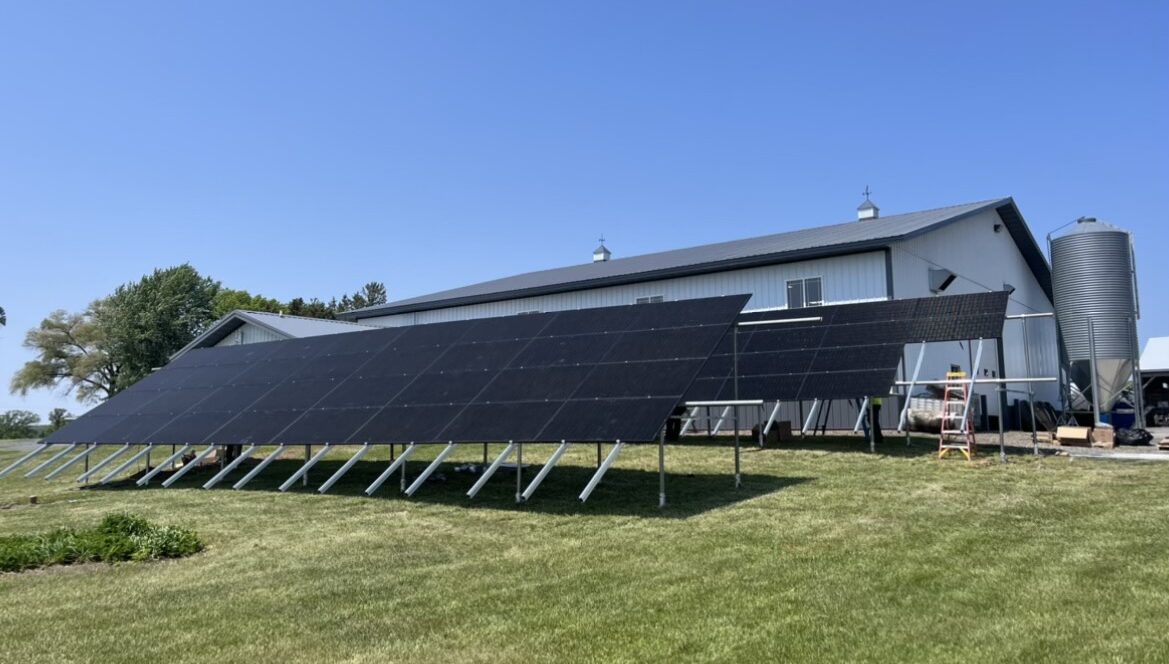
AG and Solar Partners grew from that frustration, and now Brett helps navigate federal incentives and tax benefits and connect farmers and small business owners to trustworthy clean energy businesses. One of Brett’s clients, Dan Tronrud, is an auto shop owner in Wolf River. Dan praises Brett’s passion for making solar energy accessible to his community.
When asked about his experience with applying for the REAP Grant, Dan exclaimed, “He’s excited, and he gets me excited. He knows everything about solar and electricity and is so good at breaking it down. There are no questions left unanswered.”
With the help of Ag and Business Solar, Dan was able to submit his application for the December 2023 grant cycle and hopes to bring solar panels to his shop.
Brett’s background of growing up on his family farm and then going on to study business and entrepreneurship offers him a unique skill set that empowers him to navigate complex conversations with business partners, consultants, and farmers around the intricacies of implementing solar energy on a commercial scale while taking advantage of federal incentive tax benefits.
“As a business owner, the transition to solar makes total sense,” Brett said. “Politics aside, look at the numbers, they work. The math makes sense. It’s a no-brainer with the REAP grant and tax incentives.”
The benefits of transitioning to solar energy as a business decision are clear, immediate, and accessible with the help of the REAP Grant and IRA incentives.
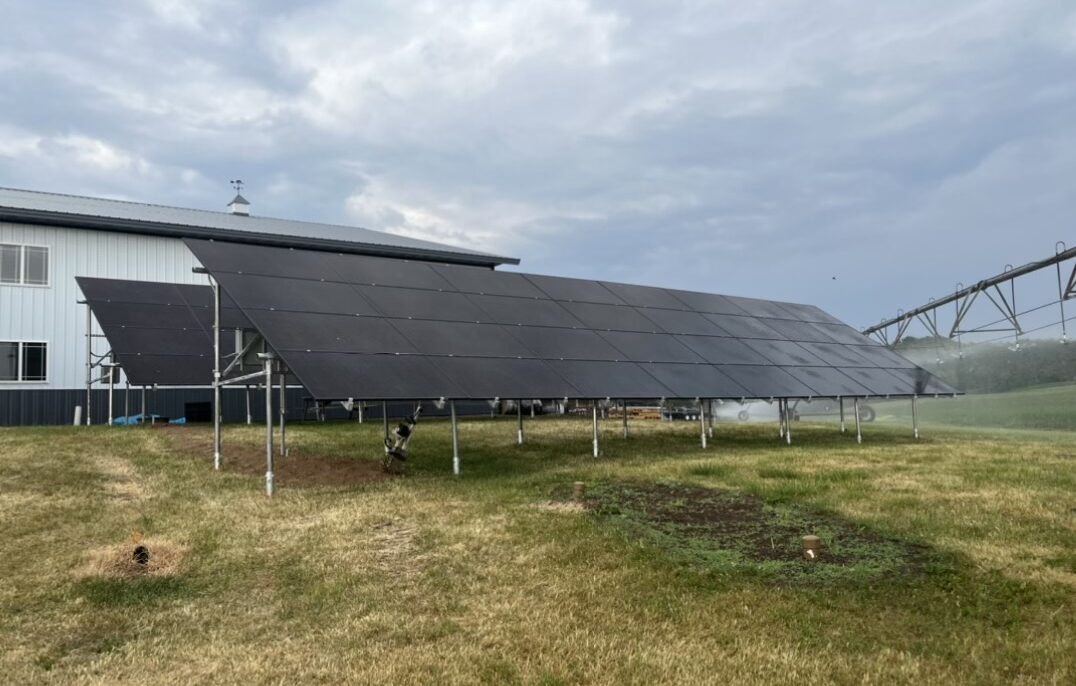
“Each generation did something innovative—something that no one else was doing,” Brett said. “My dad was way ahead of his time, he put up wind turbines, the first one in our town.”
He and his parents see solar as a partial solution to the deteriorating electricity grids in rural areas.
“It’s aging, expensive to maintain, and it’s not fair that there are no other options provided by utility companies,” Brett said. “Transitioning to solar is a way for us to have agency to protect ourselves from outdated grids. I want people to recognize how this technology benefits us. I grew up in this community, and I will spend the rest of my life here. I don’t want to keep watching my loved ones and the people that I grew up with struggle to stay in business if there is something that can be done to help. That’s why I’m doing this. I want this community to not only stick around but to thrive.”
Because of the success of past clean energy projects with the REAP grant, it will be continuously funded through the IRA with $2 billion spread throughout a ten-year span. Farmers and small business owners interested in applying for the REAP grant should send their application materials to their local Rural Development State Energy Coordinator or contact Brett. Deadlines for the 2024 grant cycles are March 31, June 30, and September 30. Funding guidelines are state and project-specific, which is where Brett’s expertise at AG and Business Partners can be useful. Brett offers free consultations for small businesses, residential properties, and farms throughout rural Wisconsin.
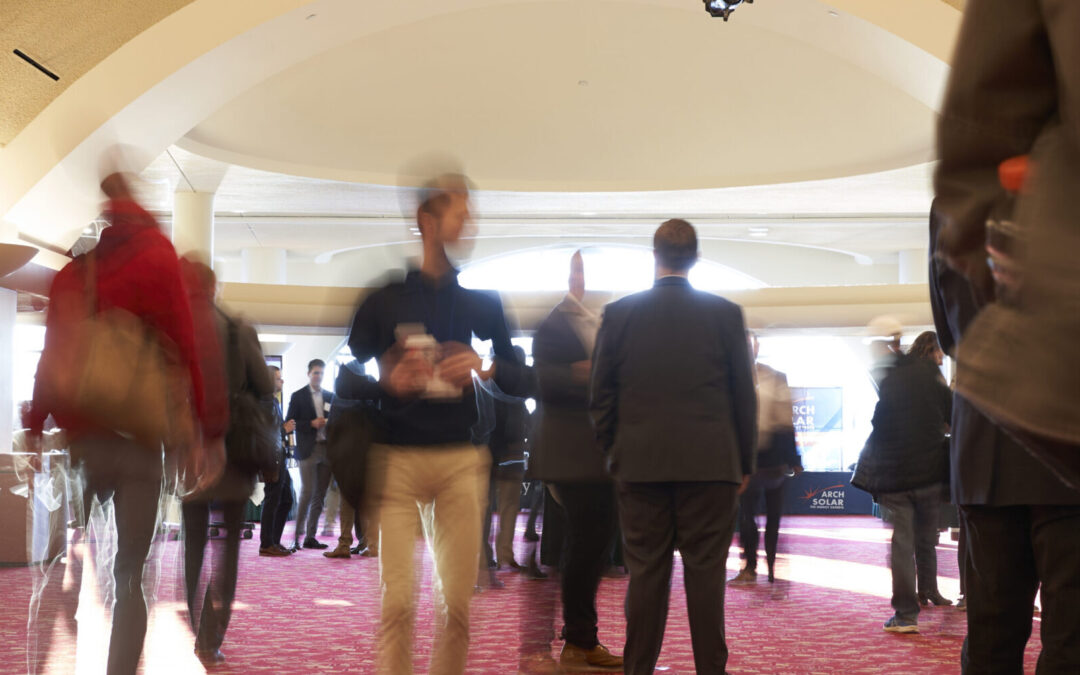
by RENEW Wisconsin | Feb 5, 2024 | Community, Events, RENEW Wisconsin
On Thursday, February 1, RENEW held our 13th annual Renewable Energy Summit, presented by Arch Solar and Invenergy. More than 700 Attendees from across Wisconsin, the Midwest, and even around the globe joined us as we discussed how to unleash the power of Wisconsin’s clean energy potential.
Our amazing cast of panelists, presenters, and guest speakers covered:
- Emerging Technologies: Delve into the latest breakthroughs in clean energy technologies, from advanced renewables to energy storage and grid innovations.
- Economic Transformation: Explore how the clean energy sector is reshaping Wisconsin’s economy, generating jobs, and fostering economic growth.
- Community Power: Hear how community-led clean energy initiatives empower local residents to actively participate in the energy transition.
- Energy Policy and Legislation: Gain insights into Wisconsin’s evolving energy policies and regulations and hear from policymakers and legal experts about the opportunities and challenges facing the clean energy sector.
- Rural and Urban Integration: Showcase successful strategies for bridging the urban-rural divide in clean energy adoption and development.
- Inclusive Sustainability: Focus on equity, diversity, and inclusion in the clean energy sector to ensure that everyone benefits from its growth.
- Clean Energy Workforce Development: Focus on building a skilled workforce to meet the demands of a growing clean energy sector and create high-quality jobs.
- Educational Catalyst: Examine the role of education and research institutions in driving clean energy innovation and workforce development.
- Resilient Infrastructure: Address the importance of building resilient energy systems capable of withstanding disruptions and extreme weather events.
- Investment and Financing: Explore investment opportunities and financing models that support the scaling of clean energy projects.
- Collaborative Partnerships: Encourage collaboration between government, industry, academia, and local communities to foster a thriving clean energy ecosystem.
We were also joined by the likes of Tonya Hicks, Robert Blake, and State Representative Supreme Moore Omokunde. Tonya Hicks shared with attendees not only how we can go about building a diverse workforce, but why it is necessary for the success of the industry. Robert Blake talked about the potential of existing renewable energy technologies and how the industry can go about finding the workers needed to achieve that potential. And Supreme Moore Omokunde closed out the Summit with a reminder that our transition to clean energy should be equitable, and that we must ensure access to renewables for low-income and minority communities.
Attendees also learned that this would be the last RENEW Wisconsin Summit with Michael Vickerman joining us as a RENEW staff member. Though Michael does plan to retire this spring, he has promised that this won’t be the last we hear from him. Michael’s role at RENEW and in Wisconsin’s renewable energy industry cannot be understated and we’re excited to see what he gets up to in his retirement.
We are proud to say that our Summit continues to grow in size and scope. The energy and engagement at this year’s summit were inspiring, and it’s all thanks to the sponsors, volunteers, speakers, attendees, and everyone else who joins us each year to make it happen!
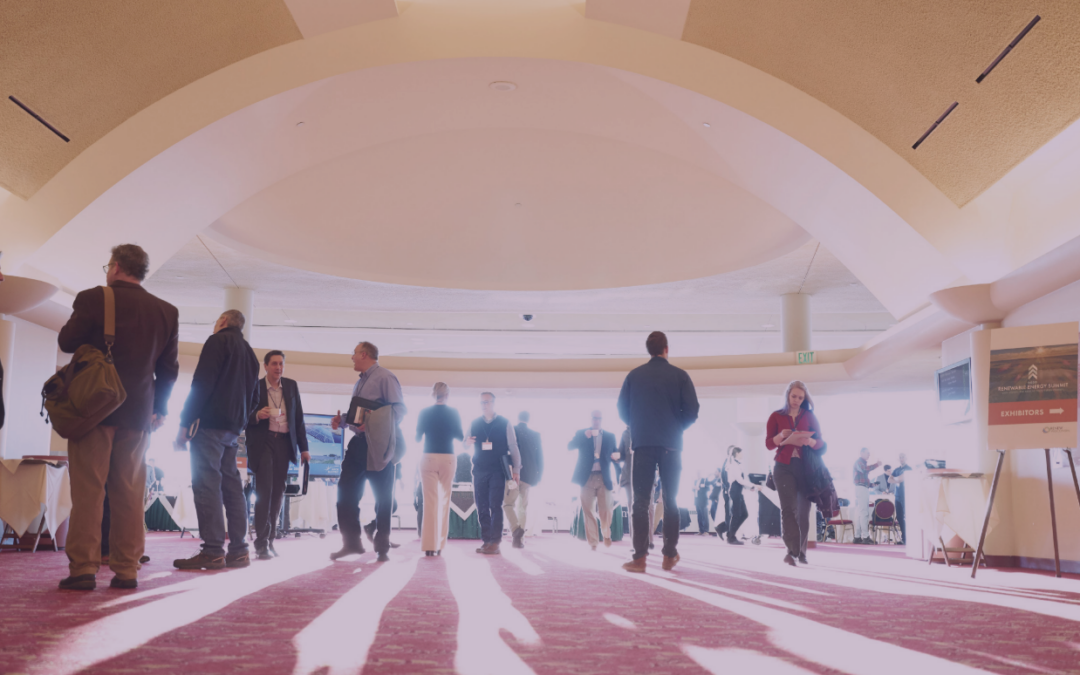
by Alex Beld | Jan 23, 2024 | Press Release, RENEW Wisconsin
January 22, 2024, Madison, Wis. — During its 13th annual Renewable Energy Summit, RENEW Wisconsin, with presenting sponsors Arch Solar and Invenergy, will honor those who made significant and lasting impacts on Wisconsin’s clean energy industry. The Summit will take place Thursday, February 1, 2024, at Monona Terrace in Madison.
RENEW’s 2024 Summit, titled “Unleashing the Power of Wisconsin’s Clean Energy Potential,” gathers industry experts, policymakers, innovators, and community leaders dedicated to accelerating the transition to clean energy sources. Featured speakers include Tonya Hicks, CEO of Power Solutions, Inc., and Robert Blake, Owner of Solar Bear and Executive Director of Native Sun Community Power Development.
The awards are grouped under three categories:
- Clean Energy Champion: Maria Drews, Co-owner – Drews Solar
- RENEW Member of the Year: Full Spectrum Solar – Madison WI
- Energy Reporting Excellence: Jana Rose Schleis, Enterprise and Investigative Reporter – The Cap Times
The ceremony will conclude with the 2023 Clean Energy Honor Roll, in which RENEW will recognize 13 clean energy projects in Wisconsin that recently commenced operation. Whether on the basis of their productivity, innovativeness, attention to detail, scale, resourcefulness, or efficacy in reducing carbon emissions, these projects showcase the skills and know-how Wisconsin stakeholders bring to the clean energy marketplace.
Clean Energy Honor Roll:
Alliant Energy Solar Portfolio, Dodge, Grant, Green, Jefferson, Rock, Sheboygan, and Waushara Counties
Eight solar PV power plants – 639 megawatts.
- Badger Hollow, Iowa County
The largest solar PV power plant in Wisconsin – 300 megawatts.
- Bayfield County, Bayfield County
Microgrid project that integrates solar PV, battery storage, and an existing backup diesel generator.
- City of Madison, Dane County
Nine (9) behind-the-meter solar PV installations – 585 kilowatts.
- College of Menominee Nation, Menominee County
Ground-mount solar PV array – 40 kilowatts.
- Holy Wisdom Monastery, Dane County
Net-zero project featuring onsite solar, with battery storage, and ground-source heat pumps.
- McFarland Public Safety Building, Dane County
Net-zero building featuring onsite solar and ground-source heat pumps.
- Red Barn Wind Energy Center, Grant County
Wind power plant – 91.6 megawatts.
- Sheboygan Senior Community, Sheboygan County
Ground-mounted solar array & battery – 198 kilowatts.
- SolarShare Wisconsin, Juneau County
Two cooperatively-owned solar arrays – 4.5 megawatts.
- UW-Health Eastpark Medical Center Garage, Dane County
Solar PV parking canopy – 1,032 kilowatts.
- UW-Parkside, Kenosha County
Ground-mounted solar PV array – 2.1 megawatts.
- Yahara Solar, Dane County
Largest solar array built for one customer – 17 megawatts.
The 13th Renewable Energy Summit will also feature an exposition hall with nearly 50 exhibitors, breakout sessions, and industry professionals discussing current and future opportunities for advancing clean energy in Wisconsin. Nearly 100 organizations have also voiced their support of renewable energy by sponsoring the summit. For more information on the 2024 Summit program agenda, speakers, sponsors, registration, or press passes, please email Alex Beld (abeld@renewwisconsin.org).












